












As North America’s most diversified steel and steel products company, Nucor is committed to delivering quality, on-time reliability, and sustainability to the renewable energy market. Our Energy Solutions team is your partner in optimizing the design and installation of your next solar and wind projects. Let’s work together to make your next project a success.

nucor.com/energy-solutions

Solar power is more to me than just the field I work in. As an avid hiker, birdwatcher and outdoor enthusiast, it’s also a passion of mine to see more clean energy like solar get deployed in this country.
I’ve been thrilled and heartened recently as I notice solar power becoming more ubiquitous in my life away from my desk. Not quite in the form of huge numbers of installations going up near me — in Ohio, cheap energy prices due to prevalent natural gas mean solar is still a luxury item for the upper-middle-class and beyond. But in the arts I consume, solar is coming up time and again.
Two books I read last year — Olga Dies Dreaming by Xochitl Gonzalez and Eleutheria by Allegra Hyde — both mention solar power to underscore the themes of utopian society and idealism. In Olga, a woman in New York City with Puerto Rican roots grapples with her responsibilities to the island in the aftermath of a devastating hurricane. Gonzalez writes about how the island’s unstable electrical grid increases demand for solar backup systems, but powerful leaders work to block energy self-reliance. Pushback ensues and leads to the formation of a resistance group demanding solar for the people called “Sol Libre.”
This fictional story lines up closely with the reality in Puerto Rico, with the island seeking resilient renewable energy solutions but continually dealing with resistance from utility powers and lack of support from the mainland. Gonzalez clearly did her research on the many policy issues that led to Puerto Ricans being kept in the dark for months after Hurricane Maria.


In the other book, Eleutheria, a woman escapes society to live on an island commune that seems utopic at first. The people on the island share the work to run a self-sufficient community — including fishing, cooking and, of course, performing O&M on the island’s solar arrays.
As with most potential utopias, something’s not quite right. But the solar panels kept the lights on despite the personality issues.
I could have glossed over these seemingly small mentions of solar technology in the two books, but they really struck me, especially reading the books one after the other. They showed me solar technology is gaining more traction, reaching more readers and hopefully more homeowners and businesses. It’s not just books, either. In the parking lot at a favorite trailhead one weekend, I walked past a car with a vanity license plate that just said “SOLAR.” With every mention in pop culture or in parking lots, more people may soon see solar power as a normal part of everyday life. That’s the future I want to live in. SPW
Kelsey Misbrener














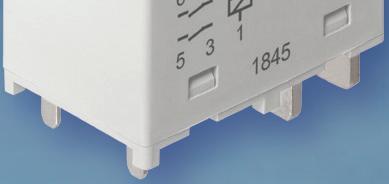









































PUBLISHER
Courtney Nagle cseel@wtwhmedia.com 440.523.1685
EDITORIAL
Editor in Chief Kelly Pickerel kpickerel@wtwhmedia.com @SolarKellyP
Managing Editor Kelsey Misbrener kmisbrener@wtwhmedia.com @SolarKelseyM
Senior Editor Billy Ludt bludt@wtwhmedia.com @SolarBillyL
CREATIVE SERVICES & PRINT PRODUCTION
VP of Creative Services
Mark Rook mrook@wtwhmedia.com
Senior Art Director
Matthew Claney mclaney@wtwhmedia.com
Senior Graphic Designer Allison Washko awashko@wtwhmedia.com
Graphic Designer
Mariel Evans mevans@wtwhmedia.com
Director, Audience Development
Bruce Sprague bsprague@wtwhmedia.com
WTWH Media, LLC : 1111 Superior Avenue, Suite 2600, Cleveland, OH 44114


Ph: 888.543.2447 | Fax: 888.543.2447
MARKETING
VP of Digital Marketing
Virginia Goulding vgoulding@wtwhmedia.com
Digital Marketing Manager Taylor Meade tmeade@wtwhmedia.com
Digital Marketing Coordinator Emily Gillespie egillespie@wtwhmedia.com
Digital Production/ Marketing Designer Samantha King sking@wtwhmedia.com
Marketing Graphic Designer Hannah Bragg hbragg@wtwhmedia.com
Webinar Manager Matt Boblett mboblett@wtwhmedia.com
Webinar Coordinator Halle Sibly hkirsh@wtwhmedia.com
ONLINE DEVELOPMENT & PRODUCTION
Web Development Manager B. David Miyares dmiyares@wtwhmedia.com
Digital Media Manager Patrick Curran pcurran@wtwhmedia.com
Digital Production Manager Reggie Hall rhall@wtwhmedia.com
Front End Developer
Melissa Annand mannand@wtwhmedia.com
Digital Production Specialist
Nicole Lender nlender@wtwhmedia.com
Digital Production Specialist

Elise Ondak eondak@wtwhmedia.com
IN-PERSON EVENTS
Events Manager
Jennifer Kolasky jkolasky@wtwhmedia.com
Event Marketing Specialist Olivia Zemanek ozemanek@wtwhmedia.com
Events Manager
Brittany Belko bbelko@wtwhmedia.com
Customer Service Manager
Stephanie Hulett shulett@wtwhmedia.com
Customer Service Representative
JoAnn Martin jmartin@wtwhmedia.com
Customer Service Representative Tracy Powers tpowers@wtwhmedia.com
SOLAR POWER WORLD does not pass judgment on subjects of controversy nor enter into disputes with or between any individuals or organizations.
SOLAR POWER WORLD is also an independent forum for the expression of opinions relevant to industry issues. Letters to the editor and by-lined articles express the views of the author and not necessarily of the publisher or publication. Every e ort is made to provide accurate information. However, the publisher assumes no responsibility for accuracy of submitted advertising and editorial information. Non-commissioned articles and news releases cannot be acknowledged. Unsolicited materials cannot be returned nor will this organization assume responsibility for their care.
SOLAR POWER WORLD does not endorse any products, programs, or services of advertisers or editorial contributors. Copyright©2023 by WTWH Media, LLC. No part of this publication may be reproduced in any form or by any means, electronic or mechanical, or by recording, or by any information storage or retrieval systems, without written permission from the publisher.
Customer Service
Representative
Renee Massey-Linston renee@wtwhmedia.com
Customer Service
Representative Trinidy Longgood tlonggood@wtwhmedia.com
FINANCE
Controller Brian Korsberg bkorsberg@wtwhmedia.com
Accounts Receivable Specialist

Jamila Milton jmilton@wtwhmedia.com
VIDEO SERVICES
Videographer Garrett McCafferty gmcca erty@wtwhmedia.com
Videographer Kara Singleton ksingleton@wtwhmedia.com
SUBSCRIPTION RATES: Free and controlled circulation to qualified subscribers. Non-qualified persons may subscribe at the following rates: U.S. and possessions, 1 year: $125; 2 years: $200; 3 years $275; Canadian and foreign, 1 year: $195; only U.S. funds are accepted. Single copies $15. Subscriptions are prepaid by check or money orders only.

SUBSCRIBER SERVICES: To order a subscription or change your address, please visit our web site at www.solarpowerworldonline.com
SOLAR POWER WORLD - VOLUME 13 ISSUE 2 - (ISSN2164-7135) is published 7 times per year: January, March, May, July, September, November and December by WTWH Media, LLC, 1111 Superior Avenue, 26th Floor, Cleveland, Ohio 44114. Periodicals postage paid at Cleveland, OH and additional mailing o ces.

POSTMASTER: Send address changes to Solar Power World; 1111 Superior Avenue, 26th Floor, Cleveland, Ohio 44114.















CONTENTS
2 8 54 56
ON THE COVER
14 FIRST WORD SOLAR POLICY SCOOP CONTRACTOR’S CORNER AD INDEX

BUSINESS INSTALLATION
OFF-GRID EV CHARGERS
All-in-one solar-powered EV charging units save time and money by avoiding interconnection

POLICY
SOLAR Low-income 32
CASE STUDY
A solar microgrid on a former landfill powers Pittsburgh International Airport terminals

22 36
LOW-INCOME 10 18 42
INVERTERS
New IRA tax credits may not be enough to bring inverter manufacturing stateside

MOUNTING
Rooftop transport solutions help installers hoist heavier panels more safely
PANELS
Transparent solar window technology may finally have its moment thanks to organic semiconductors
STORAGE
Bidirectional EV charging opens new installation opportunities and revenue streams
SPECIAL SECTION: INSTALLATION TIPS

As PV technology evolves, solar installers are finding new ways to make rooftop projects safer and more efficient.
















New Illinois law prevents counties from banning local wind and solar projects

SPRINGFIELD, ILLINOIS
Gov. J.B. Pritzker signed a law prohibiting counties from enacting pre-emptive local ordinances that outright ban local wind and solar projects. Over a dozen local bans were initiated before this legislation, but the state law will now take precedence over those bans and help Illinois reach clean energy goals.
Treasury releases first guidance on low-income and tribal ITC adders
















WASHINGTON, D.C.
The Dept. of the Treasury issued initial guidance on the Inflation Reduction Act’s ITC adders for lowincome and tribal solar projects. The Dept. of Energy will be the administrator of the program and will begin accepting applications for solar projects benefitting affordable housing and economic benefit communities in Q3 2023.
New coalition urges California to create Western Regional Transmission Organization
SACRAMENTO, CALIFORNIA
A coalition called Lights on California, which includes SEIA and other clean energy organizations, is pushing the state to create a Western Regional Transmission Organization to establish shared energy governance across 11 western states. The coalition argues that an RTO like this could help all western states meet renewable energy goals and make energy more affordable.
A new bill in Georgia would improve and expand community solar by allowing tax-exempt customers to aggregate demand from multiple locations and subscribe to an off-site solar facility under 3 MW. The bill would also raise the rooftop solar program cap from 0.2% to 5% of the prior year annual peak demand to give markets time to mature.
Gov. Phil Murphy announced an executive order that includes an accelerated goal for New Jersey to reach 100% clean energy by 2035, 15 years earlier than the previous target. The governor also created new goals for electrification of homes, commercial properties and low- to moderate-income (LMI) properties.
THE USA
The N.C. Clean Energy Technology Center found in its 2022 annual review that 46 states plus Washington, D.C., took some action on solar policy last year. Most actions were related to net-metering, community solar and residential fixed-charge increases.











The Center for Biological Diversity and two other environmental justice groups appealed the California Public Utilities Commission’s decision to significantly slash compensation to the state’s rooftop solar customers in NEM 3.0. The appeal asks that the CPUC redo its analysis due to flawed modeling.
New legislation sponsored by Maryland Sen. Brian J. Feldman and Delegate Lily Qi would increase the state’s residential clean energy grant from $1,000 to $5,000 to incentivize rooftop solar installations. The Maryland Rooftop Solar Coalition is pushing for this legislation to revitalize the state’s solar industry and expand equitable access.
On February 3, the Minnesota State Senate passed the year’s first 100% clean energy bill and sent it to Gov. Tim Walz’s desk. The legislation mandates a transition to 100% carbon-free energy by 2040 and also includes investments into environmental justice communities.

WASHINGTON, D.C.
Earthjustice filed a complaint asking federal regulators to order the Midcontinent Independent System Operator to stop prohibiting wind, solar and battery hybrid resources from providing additional gridsupportive services. The group says ancillary services are critical to ensuring the stability of the electrical grid.
WASHINGTON, D.C.
The Biden Administration signed a proclamation that imposes a 200% tariff on aluminum imports from Russia, calling such imports a threat to national security, according to an investigation conducted by the Secretary of Commerce. Aluminum is a common material found in solar panel frames and racking and structural mounts used on PV arrays.
New legislation in Vermont would reform the state’s 2015 Renewable Energy Standard, which advocates say has led to over-reliance on existing renewable energy resources to meet standards. If the bill passes, it will require Vermont utilities to get 60% of their power from new renewables.






















for electrifying transit is higher than it’s ever been, yet the process for interconnecting the necessary energy-generating systems to the grid is often long and arduous.
Whether it’s a solar project, EV charger or energy storage system, utilities must assess individual energy project sites to see if the grid requires upgrades to accept the added capacity.
“The grid’s just not big enough,” said Tom McCalmont, CEO of Paired Power, which manufactures off-grid EV chargers. “There’s a lot of interest in fully electrifying now across the country, and the politicians are finally excited about it, but they don’t really understand electricity that well and they don’t realize the demand that’s going to put on the grid.”
A study by the Lawrence Berkeley National Laboratory found that more than 600 GW of solar and 400 GW of energy storage projects were stuck in the interconnection queue at the end of 2021. EV chargers, even though individually smaller and more compact than solar and storage systems, must undergo a similar interconnection process, one that can take months or years to complete.
“It’s a difficult process, especially in California,” McCalmont said. “Companies that want to put in 10 or 20 EV chargers in California, that typically requires a new service drop from the utility because your capacity on your existing service drop is not going to be big enough. And that’s a two-year wait.”
But by combining solar, storage and EV chargers –– technologies with long respective interconnection
queues –– into single off-grid systems, it’s possible to avoid interconnection altogether.
All-in-one off-grid EV chargers
Manufacturers have recognized the need for more public EV charging and in turn developed packaged solutions to make turnkey off-grid EV chargers. These units come with solar panels, inverters, battery storage, EV chargers and support structures, and they are often able to be disassembled and redeployed. And when a system is off the grid, there is no long wait for utility approval.
Paired Power of Campbell, California, has pioneered off-grid EV technology and has manufactured solar-powered EV charging solutions since 2015, producing hardware used on hundreds of projects. Its newest off-grid product is PairTree, a pop-up solar canopy that uses 5 kW of bifacial solar modules, a 40-kWh battery, a ballasted foundation or ground screws and Paired Power’s proprietary charger, the SunStation.
“The pop-up aspect allows workers to build it standing on the ground, but then raise it up,” McCalmont said. “One of these challenges with traditional solar canopies is the workers are going up and down on scissor lifts all day. It’s very labor-intensive. So being able to stand on the ground, it facilitates a much faster and simpler assembly process, and no lifts.”
The inverter, battery and charger are housed in a metal enclosure. SunStation comes in two models, SunStation HPC (High-Powered Charger) and SunStation Level 2 Charger. HPC is a direct-to-DC, 60-kW EV charger that’s installed on
carport or ground-mounted solar projects. And the Level 2 Charger comes standard on PairTree.
BoxPower of Grass Valley, California, is another turnkey off-grid EV charger supplier. It started as a Princeton University research project exploring alternatives for diesel generators.
“We thought we’d be working in places where there’s a less-reliable grid internationally, but then quickly saw a huge need domestically, especially in California where we’re based, with the wildfires and the PSPS (public safety power shutoff) events associated with that,” said Anderson Barkow, co-founder and CFO of BoxPower.
The company produces prefabricated, portable off-grid power plants built within shipping containers, which lend themselves to simpler transit and modular design. These solar + storage shipping containers can also be outfitted with EV chargers.
The four primary components of BoxPower’s EV chargers are solar panels, batteries, inverters and the charger itself. Modules can be installed in a single pitch or at a dual tilt on racking attached to the shipping container. BoxPower can link multiple containers together to meet increasing energy demand and the system is outfitted with software that lets operators monitor and control the system remotely.
Energy storage manufacturer Yotta Energy is also breaking into the off-grid EV charging space with REV.
“It was really seeing an opportunity where we could take some of the technology that we’ve developed here on battery thermal
management and knowhow and power conversion,” said Omeed Badkoobeh, CEO of Yotta Energy. “And it started off as a side project. We said, ‘There’s not a lot of people operating in this space, and it seems to be a pretty potential market opportunity.’”
REV comes in two models: REV Core and REV Core XL, which can be installed with 15 to 34 kW of bifacial solar modules and 50 to 300 kWh of lithium-iron phosphate battery storage, respectively. Each uses a 24-kW EV charger, with Core able to charge up to 240 miles and Core XL up to 510 miles daily.
The solar modules are installed in a "butterfly" design, with two sections of panels angled upward off either side of the charger in an east-west orientation. This ensures steadier power production throughout the day, instead of a peak at midday. In addition, REV has an access panel with outlets for 50 amps of emergency backup power.
There are other companies like Beam Global producing solar-powered off-grid EV charging solutions, and with newer
entries from Paired Power, Yotta Energy and BoxPower, the space is expanding.
There are many use cases for off-grid EV charging. There are certainly customers in remote locations that want to build charging infrastructure where there is no grid support. Business owners that lease commercial buildings can use offgrid charging, too, because they may be unable to add a permanent charging station and the electrical trenching it requires.
In both cases, it’s likely that the offgrid permitting process is much simpler than trying to tie the chargers to the grid.
“For a lot of installations, it’s going to be ‘de minimis’ –– maybe none at all,” Paired Power’s McCalmont said. “Certainly, in rural locations. Typically, in a lot of AHJs, if it’s a temporary structure, which means it’s designed to be removed or is capable of being removed, no permit is required. We know in some cities they’re not going to be quite that liberal. They’ll probably
want a streamlined permit process where they do something like evaluate it structurally.”
Avoiding the interconnection queue and the costs associated with it can make off-grid EV chargers much more affordable. Ampcontrol, an EV-charging optimization software developer, estimates that it costs about $1,000 to connect 1 kW of charging capacity to the grid — and that’s on top of the cost of the chargers themselves.
To recoup costs, some off-grid charger owners choose to monetize the charging services. But manufacturers said other customers like municipalities and national parks that install these chargers in more remote locations where there is no grid infrastructure usually offer charging for free.
Both off-grid and grid-tied chargers will be necessary to meet demand as EVs become more popular. Solar + storage technologies will undoubtedly play a role in that buildout. SPW
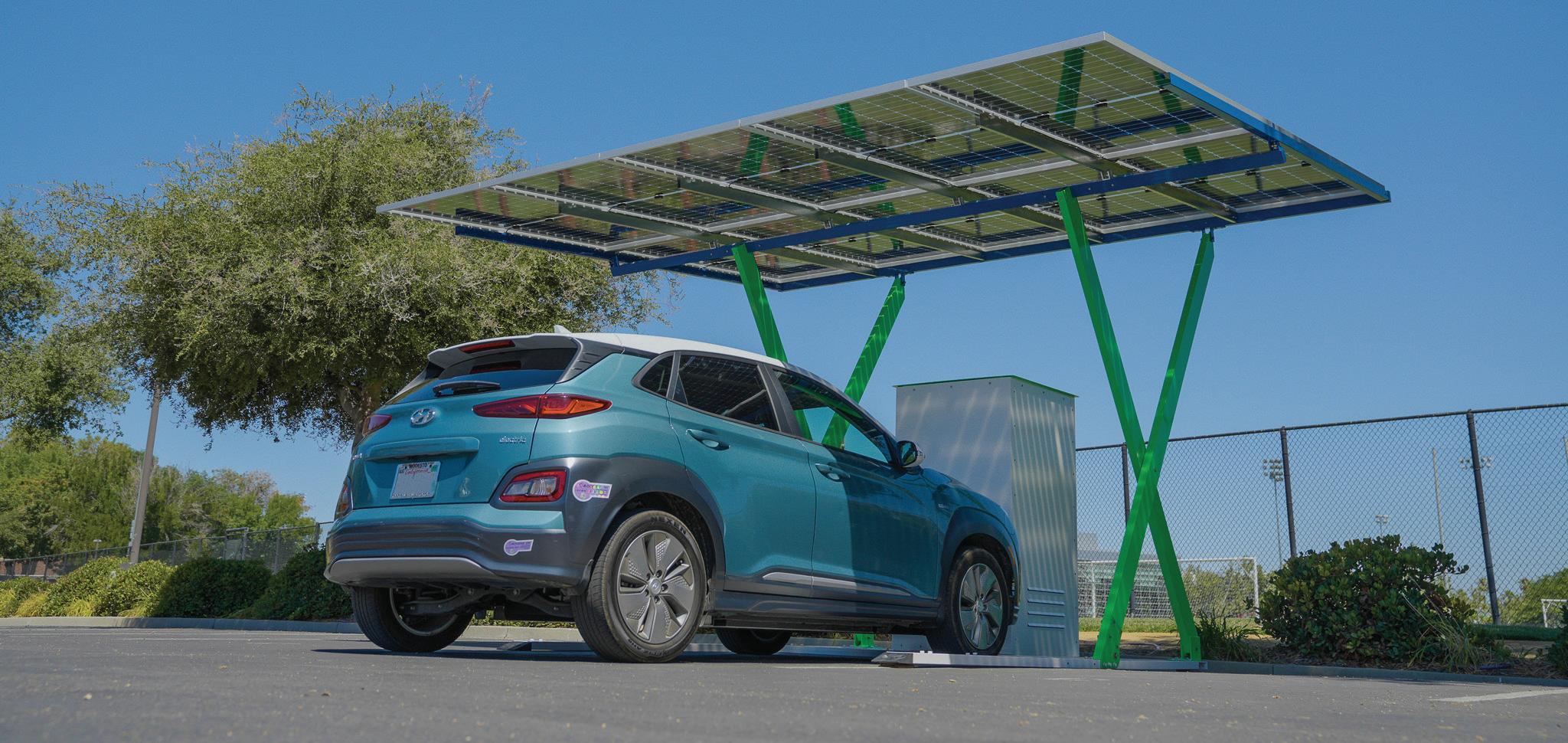















The program structure will make it difficult for smaller residential and commercial projects to win out, but changes are expected for 2024.
TheInflation Reduction Act (IRA) included some substantial tax credit add-ons for solar projects sited in low-income communities, but the industry didn’t receive further detail on those credits until mid-February.
While solar and environmental justice advocates said they appreciate the government incentivizing solar projects for underserved populations, the Dept. of the Treasury's initial guidance left many confused and concerned about the program structure.
"First of all, we're thrilled with the program inclusion in the IRA, and Treasury and DOE's efforts to implement it in equitable ways," said Andie Wyatt, policy and regulatory manager at GRID Alternatives, a nonprofit solar training and installation organization. "Like other environmental justice advocates, we want the most community-led and community-benefitting projects to be at the front of the line for this capacity from the outset."
Wyatt said the current setup for 2023 does not hit those marks for a number of reasons.
The biggest issue GRID sees pertains to the placed-in-service guidelines — any projects placed in service prior to being awarded an allocation of capacity are not eligible for the credit.
"Placed in service" in this context means either the date when property depreciation begins or when the project is placed in a "state of readiness" and "availability for a specially assigned function," whichever happens first.
The placed-in-service structure may be less of a problem for large projects with a long time period between project planning and operation, but timelines are shorter for smaller residential and commercial projects and can't be paused while the owner secures a credit.
"It's just incompatible with the days or weeks or months at most timelines for residential clean energy projects," Wyatt said. "By slipping this sentence in the guidance and making it structured in this way, it's really limiting its value as a tax credit to shift the solar at every scale into the communities that bonus credits are supposed to be targeting."
The current application process only adds to the struggle for the residential and small commercial market to clinch these incentives. DOE will accept applications during a 60day window starting in Q3 2023, prioritizing low-income residential building and economic benefit projects first, with applications for other projects to follow. Only the facility owner may apply for an allocation, and that applicant can only apply in one category for the calendar year. If they don't receive an allocation, they will be eligible to apply again the following year.
• A project must be awarded an allocation before being placed in service
• “Placed in service” means either the date property depreciation begins or when the project is placed in a “state of readiness” and “availability for a specially assigned function,” whichever happens first
• Once awarded an allocation, projects must be placed in service within four years
• Only the owner of a facility can apply for an allocation
• If a project does not receive an allocation for 2023, the applicant is allowed to apply again the following year
• There will be no waitlist for applications
• The first 60-day application period will begin in Q3 2023
• The first projects that will be accepted are those serving affordable housing and economic benefit communities, followed by low-income communities and Tribal lands
• The Dept. of Energy will be the administrator of the overall program
• Future Treasury guidance will outline specific application procedures, additional criteria, definitions and more
• The program is subject to change for 2024 depending on Treasury assessments
"Treasury's guidance basically ensures that it's mainly big developers and big, already-in-the-pipeline, 5-MW projects that will be able to actually use the credits in 2023," Wyatt said.
But even larger community solar developers have concerns about this placed-in-service restriction and Q3 application process.
"Now everyone's saying, 'Do I just delay all my projects?'” said Georgina Arreola, VP of policy at community solar subscription company Perch Energy. "We've gone from, 'All right, early in the year, we're going to get something and we're going to push forward and get as many projects out the door [as possible],' to, 'Maybe I don't do anything this year.'"
Moving forward from this tough interim year, GRID and other advocates are pushing for a switch to a rolling application process to give smaller, deserving low-income projects a shot at the credits.
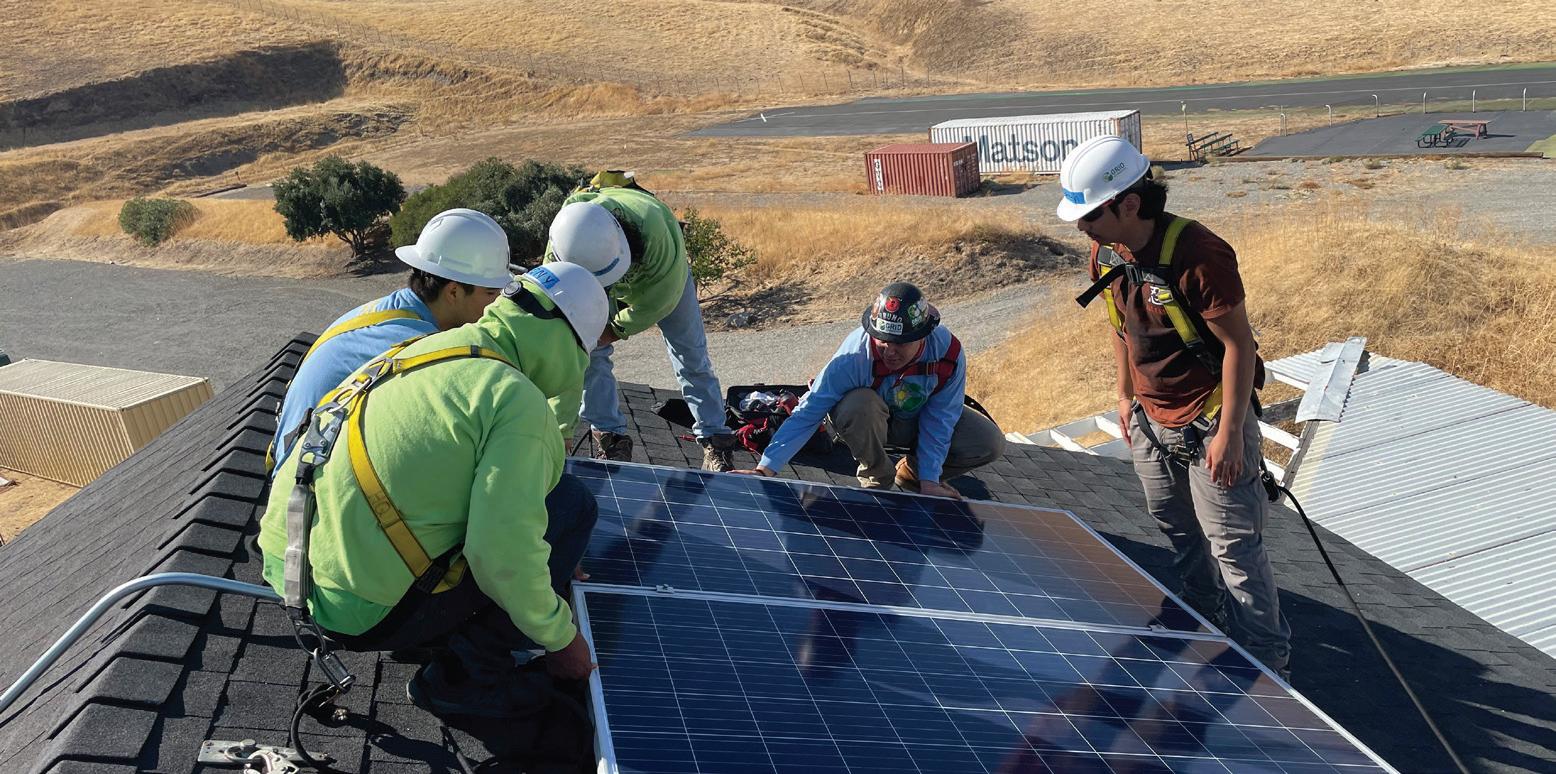
"We need to have clarity in our contracts upfront about the benefits that we can pass through to our rooftop clients," Wyatt said. "We can't make them take that gamble and have that kind of a weight. It's just fundamentally incompatible with the business model and timelines."
The IRA statute capped the low-income incentive program at 1.8 GW, but did not outline how those credits should be allocated. In Treasury's initial guidance, the allocation is based on the four different credit categories:
• 700 MW for facilities in low-income communities
• 200 MW for facilities located on Tribal lands
• 200 MW for facilities serving affordable housing facilities
• 700 MW for facilities where at least 50% of the financial benefits of the electricity produced go to households with incomes below 200% of the poverty line or below 80% of area median gross income
Solar industry officials who were part of discussions with Treasury said this differs from the best practices expressed in those meetings. Instead, they were looking for the incentives to be allocated based on solar sector to ensure everyone gets a fair share.
"SEIA, Vote Solar and a bunch of other people got together and said what would be fair so that no industry cannibalizes the other one," said Perch
Energy's Arreola. "[They] made a lot of recommendations about apportioning a certain percentage to community solar, a certain percentage to rooftop solar, commercial, what have you, and [Treasury] didn't follow that guidance, unfortunately."
Other unclear areas of the guidance are the issues of oversubscribed categories, waitlists and yearly rollover. As of now, Treasury and the IRS have discretion to reallocate excess capacity to oversubscribed categories, and any unallocated 2023 capacity will roll over to the following calendar year. The methods for reallocating are not yet described, and there is no waitlist established in the guidance.
The need for further clarity on the many facets of this program also impacts some state-level low-income solar policies, where officials were waiting on federal guidance before setting forth their own complementary programs.

"A number of states like New York said, 'As soon as the guidance comes out, we're going to give you clarity on all these adders that we've been holding back on releasing.' Now, that clock is sort
of reset without a firm date as to when that additional guidance is coming," Arreola said. "It arguably introduces more uncertainty and potential for slower growth than we had anticipated."
While 2023 will be a work in progress, there is plenty of hope that a lot of these issues can be mitigated by the time 2024 rolls around. The Dept. of Energy has been tapped to be the administrator of the Low-Income Communities Bonus Credit Program.
"The Dept. of Energy's been really great with all the work they're doing with NCSP (National Community Solar Partnership), and they've been really open to learning and figuring out what works and what doesn't," she said. "So it was nice to see that DOE is going to be leading the administrative effort, because I think there's a lot of good knowledge transfer that's been going on there."
Treasury has also been clear that this is only the beginning of guidance for this credit subset. Future notices will outline specific application procedures, additional criteria, definitions and other
helpful information. The guidance also noted that Treasury and the IRS will be monitoring the program rollout and assessing whether modifications are needed in 2024.
Solar industry representatives from groups like the Coalition for Community Solar Access (CCSA) and Vote Solar are continuing to meet with government leaders to push for more alignment with best practices for low-income solar growth at all levels.
"While there is still work to be done to ensure the program deploys solar projects that will provide meaningful benefits to low- and moderateincome communities, we are strongly encouraged that the administration is actively engaging with industry and other key partners to make the program a success," said Mike Judge, VP of policy at CCSA, in an email. "Developers and other contractors should be aware that the 2023 guidance is still not final and may differ from how the program operates in 2024 and beyond. We're working with Treasury so that we can start delivering bill savings to low-income families that need help now." SPW





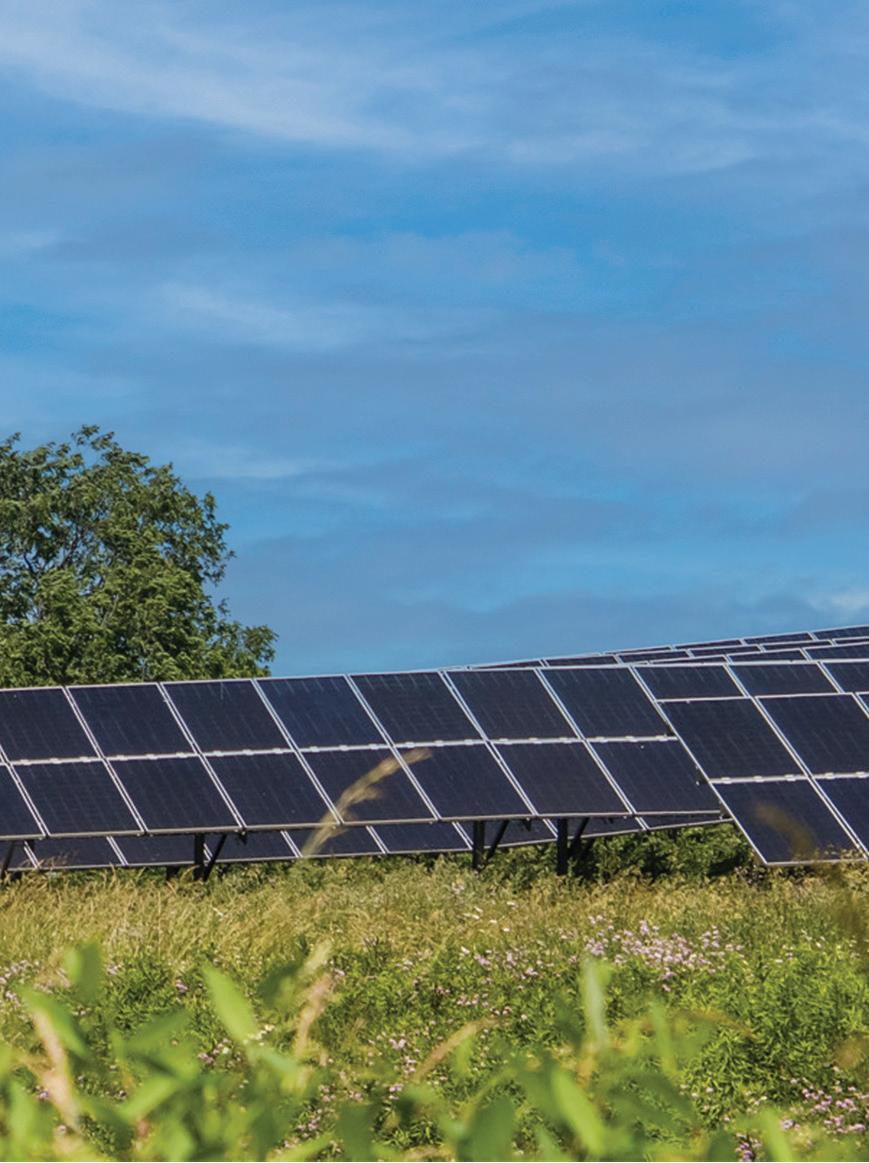







More than 8 million people took a flight from Pittsburgh International Airport in 2022, but they likely didn’t know the airport’s terminals, shops, restaurants, trams and other facilities are all operating on a separate electrical grid powered by a solar array and natural gas-fueled generators.
PIT is the first airport in the country to use a dedicated microgrid. Its development was motivated by an 11-hour blackout at Hartsfield-Jackson Atlanta International Airport in Atlanta in 2018, which called into question the energy resiliency of airports across the country.
PIT has nonstop flights to 125 locations and on average saw more than 20,000 passengers a day in December 2022. A delay in operations could be logistically and economically catastrophic.
Today, PIT is powered by this dedicated solar + generator microgrid, but the airport and project developers had to lay new runways for energy resilience in the aviation industry for it to happen.
Despite an immediate desire to build energy resilience into the airport, it was several years after initial discussions that this microgrid project was permitted
for construction. That permitting process lasted through the early COVID-19 pandemic and the several months that Pennsylvania designated solar construction as non-essential work.
Peoples Gas, a multi-state gas utility, was hired to develop the microgrid project and worked with IMG Energy Solutions, EIS Solar and Hanlon Electric Company to bring the project to fruition. They were finally granted permission to start construction on January 1, 2021.
“We started construction literally 48 hours later — we were ready to go,” said Tom Woodrow, senior VP of engineering and intelligent infrastructure for the
Allegheny County Airport Authority, the municipal authority that manages PIT. “Those guys built that thing during the height of the pandemic from January and were online and flipped the switch the second week of July.”
An unusually dry Pennsylvania winter allowed installers to work through that typically tough season. The total microgrid is 20 MW, with solar contributing 3 MW. The array was installed on the southern edge of the airport’s property that borders Interstate 376 — on a hillside site originally used as a landfill for construction debris from when the airport was rebuilt 30 years ago.
The solar portion of Pittsburgh International Airport’s microgrid uses a combination of driven pile and ballasted foundations. Billy

“Part of our sustainability aspect of this project is we were able to build a renewable energy facility on top of land that is otherwise unable to be developed,” Woodrow said.
Another first for this microgrid endeavor was the Pennsylvania Department of Environmental Protection (DEP) had never permitted a solar project on a landfill. Woodrow said the DEP has since used its experience with the PIT solar landfill array as a touchstone for similar projects.
Foundations on the solar array are a combination of driven piles and concrete ballasts.

The airport’s landfill isn’t capped like those containing organic waste, so installers could make
ground penetrations without risk of contamination.







“Because it’s a landfill, occasionally you’re going to hit something,” said Mike Brady, CEO of IMG Energy Solutions. “Some of the ballasts near the edge of the landfill cap, we didn’t have enough depth there that we felt that it was safe to drive a post, because if they do sink it could compromise the bottom of the landfill.”
Given that the landscape is on both a hill and a landfill, solar installers used skid steers and smaller models of pile-driving machines to minimize surface impact on the site.



The solar array uses 9,360 VSUN 390-W bifacial panels, RBI Solar (now Terrasmart) racking and Sungrow


THAT WORKS LIKE A MACHINE
I think that any piece of land that doesn’t have another use or any rooftop that doesn’t have anything on it should be covered with solar panels.
SG125HV string inverters. Installers poured a concrete foundation and hung the inverters on support beams under a covered wooden roof to protect them from the elements.

An apiary of several beehives is also located across the road from the solar array, so developers planted native vegetation on the site to assist the pollinator habitat.
Sustainable flight path
PIT signed a 20-year energy service agreement with Peoples to pay for the energy produced by the microgrid, and IMG owns and handles maintenance of the solar project. In almost two years, the airport has already saved more than $1 million on energy costs by using the microgrid.
The solar portion of PIT’s microgrid supplies about 5% of its total energy output, with the natural gas generators handling the rest. The airport set aside 20 acres for solar, but the 3-MW array only covers eight due to earlier regulatory limits on solar array sizes. However, there are already plans in the works to expand the facility with new approval from PJM.

In the meantime, PIT is building a new terminal that will pursue LEED certifications with considerations for reducing waste, water, emissions and energy production. And perhaps there will be some more solar for Pittsburgh International Airport in the future.
For now, the airport has more than one reason to hope for clear skies.
“I think that any piece of land that doesn’t have another use or any rooftop that doesn’t have anything on it should be covered with solar panels because it reduces the amount of power that we have to place on power plants and infrastructure,” Brady said. “As we look to electrify everything, if that’s truly where we’re going, you’re going to have to find solutions like this, where you’re building on available land and in a fuel-free type of energy supply.” SPW






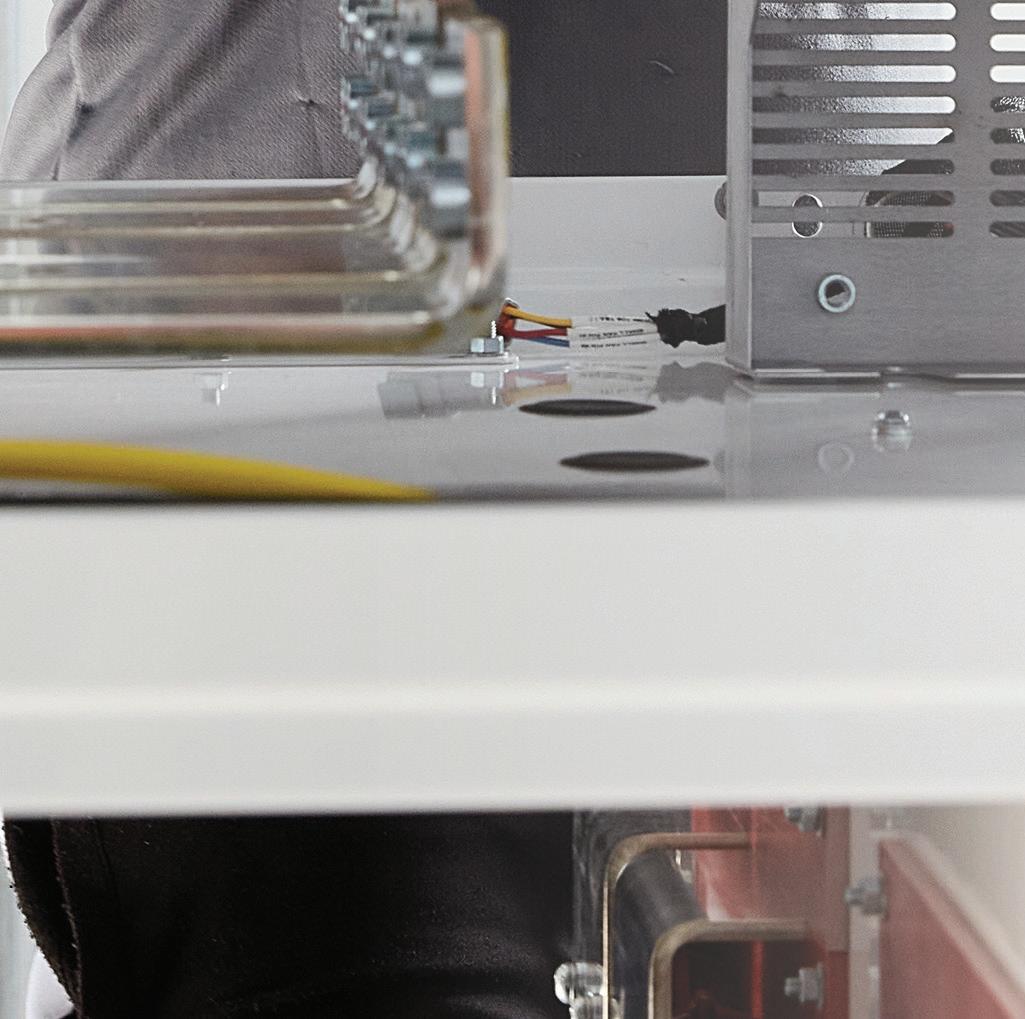






solar product manufacturing have already yielded significant groundbreakings and expansion announcements for solar panel makers. Qcells, First Solar and JA Solar are just a few of the module manufacturers planning to open new facilities in the United States, even before the Dept. of the Treasury releases more specific guidance on how to qualify for the incentives.
to be a harder sell for the inverter market — tax incentives or not. Only 10 of the 32 most popular U.S. power electronics brands do any part of manufacturing stateside, and companies are still hesitant to commit to any U.S. manufacturing even with new tax credits.
aside credits for five different categories of inverters:



































































Central inverter (>1 MW

Utility inverter (>125 kW ): 1.5¢/W
Commercial inverter (>20 kW ): 2¢/W
Residential inverter (<20 kW
Microinverter (<650 W connects with one solar module):
Some manufacturers are hesitant to make any moves into domestic manufacturing because they don't fit into the narrow definitions in the act. The IRA itself doesn't specify what constitutes













a U.S.-made inverter — such as how much of the product must be actually manufactured in the United States to receive credits. Many inverter parts, like circuit boards, are not made domestically and must be sourced from overseas.

IRA definitions of different inverter types pose some issues too. Microinverters can receive the largest incentive per-watt in the inverter category, but they must be both less than and connect with just one solar
650 W module.
As written, the microinverter parameters really only apply to Enphase. APsystems makes microinverters that connect with either two or four modules, so the company has been working to convince Treasury to expand the


























definition.

"We have hired a firm along with Yotta Energy to work with Congress on the interpretation of the IRA to include other microinverter manufacturers outside of Enphase, like us, NEP, Hoymiles, Generac and many others. Our view is that if the intent of the new act is to encourage manufacturers to produce in the U.S., it should not benefit only
































one microinverter provider," said Jason Higginson, senior director
of marketing for APsystems.Enphase's clear qualifications for the credits have made the company one of the first to announce new U.S. manufacturing plans.
Enphase uses contract manufacturers around the world to serve different markets, with the Mexican location of original equipment manufacturer (OEM) Flex making all of its North American microinverters up to now. With the IRA incentives, Enphase has announced it will start manufacturing in the U.S. with one contract manufacturer in Q2 of 2023, followed by two others in the second half of 2023, with the goal of producing 4.8 to 7.2 GWAC of U.S. microinverters per year.
Using contract manufacturers to build its products is a strategy that lets Enphase scale much faster than building an entire factory from the ground up.
"I think there are pluses and minuses to different models, but the idea is that
we can work with multiple [OEMs] to allow us flexibility and options and the ability to negotiate terms of those deals, and we can also diversify regionally," said Andy Newbold, senior director of corporate communications at Enphase.
Contract manufacturing is a way to keep the huge expense of running a factory off a business' balance sheet, but it also means less control over the day-to-day operations and quality. Still, Enphase feels confident in its approach due to careful partner selection and collaboration when starting a new line.

"We have people who are representing Enphase that are in these factories and standing up these various
lines, and working with our contract manufacturing partners to make sure every step of the process has quality and reliability in mind," Newbold said. "Part of our selection process with contract manufacturers is working with folks who are dedicated to that as well."
Only a few inverter manufacturers have spent the capital to set up in-house manufacturing stateside. EPC Power makes dual-purpose central inverters for the storage and solar markets. The robust functionality of the inverters makes them more expensive and thus more practical for storage projects that

Our view is that if the intent of the new act is to encourage manufacturers to produce in the U.S ., it should not benefit only one microinverter provider.Enphase microinverters in progress at a Salcomp contract manufacturing factory in India.















can maximize features like grid-forming capabilities.
The company has always made inverters in the United States at its headquarters in Poway, California, and opened a new factory in Greenville, South Carolina, in late 2022. Despite the high cost of domestic manufacturing, EPC Power has had success in its ability to charge more for a premium, Made-in-America product. All of EPC's engineering and support is based in the United States, with most workers coming from other U.S. power electronics companies.
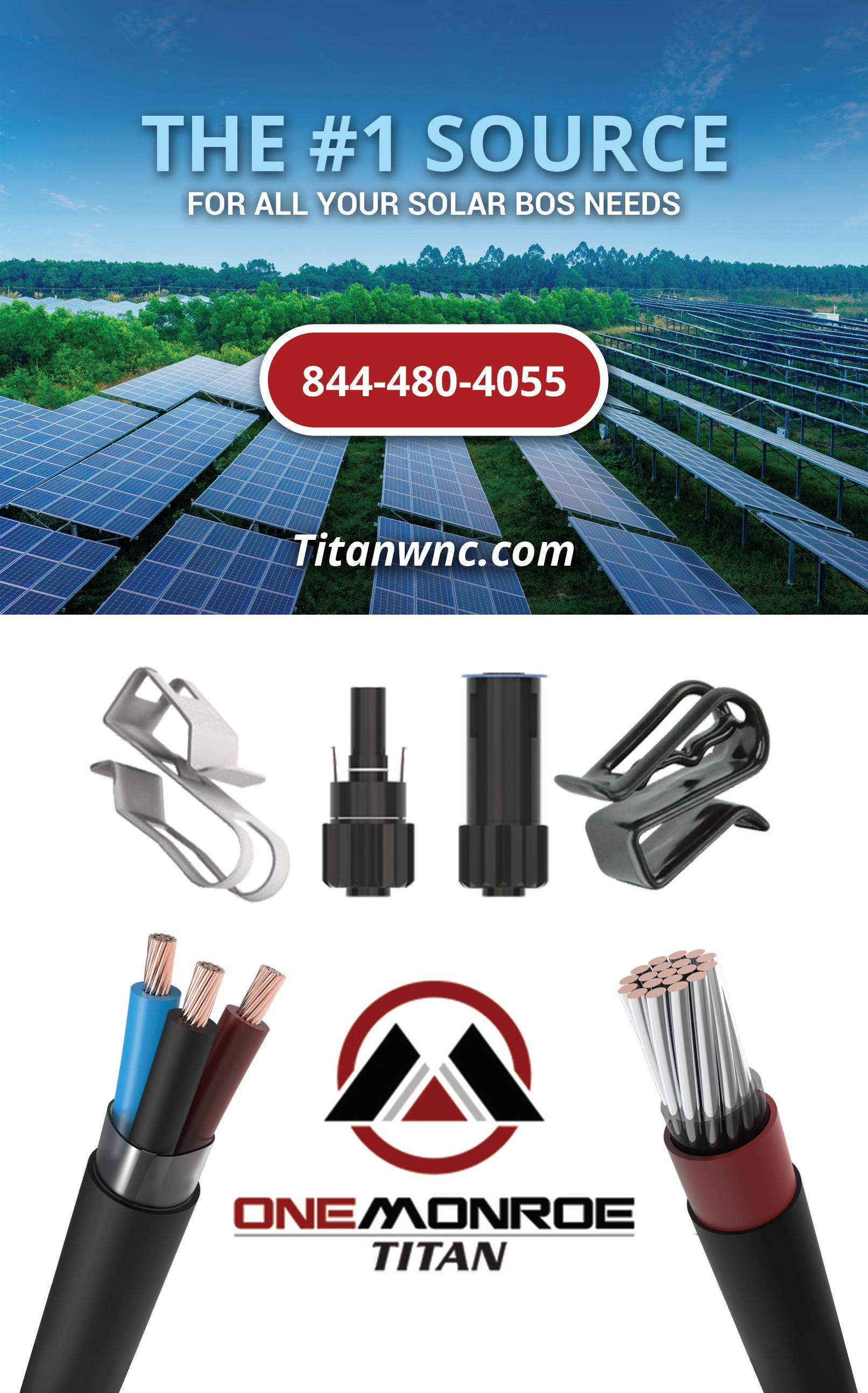
"The U.S. is a really hard market, and it will benefit from having everything local. [We've] just never deviated from that, so we never got into the race to the bottom on cost. It was more about justifying the value," said Adam Kabulski, VP of sales and marketing at EPC Power.
But EPC has had its challenges in domestic manufacturing. Finding qualified power electronics engineers was tough when opening a second plant.
"You're fighting for this highly trained, highly technical talent that's already pretty limited," Kabulski said. "It's not a real common field. There's only a handful of schools that have this as part of their curriculum."
The U.S. is a really hard market, and it will benefit from having everything local.




Seaward has the complete solar photovoltaic testing solution to support you in the field.


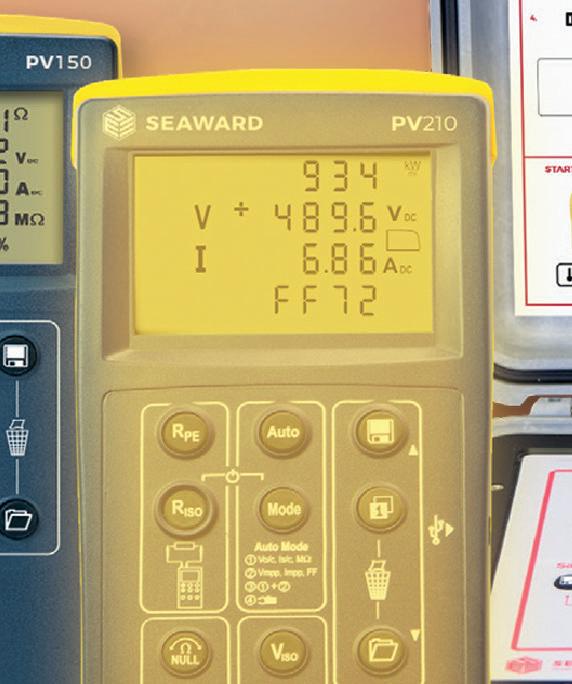





• 1000V & 1500V Testers

• I-V curve tracer


• Reporting software

• Accessory range


Despite hiring pains, EPC remains committed to in-house manufacturing for the quality assurance.
"It is really nice to own your own technology, your own manufacturing, your own quality. There are good contract manufacturers. There are many industries that use contract manufacturers very well. But having control over your own supply chain, your own manufacturing, gives you more control over your business," he said.
EPC Power is at an advantage with pre-established U.S. manufacturing, so ITC incentives would just be a bonus. Kabulski thinks overseas companies trying to bring manufacturing to the United States for the first time will face some skepticism when they price their new
products to cover the costs of a domestic plant.
"For someone that's normally a lowcost provider to come to the U.S. and all of a sudden convince people that they're a premium product, that's a hard sell. At least we've always approached it as a highfeature, high-technical solution at a higher price point. We haven't had to change anything culturally about the company," he said. "It's exciting that we have the tailwinds of the IRA, but I will not be the least bit surprised if no one else enters the U.S., just because the U.S. market changes so quickly, and that's a big investment. And there's a big world outside of the U.S. that you can also serve.
"I think it's best for the entire industry to have more options, but we're excited to already not have to worry
We offer fabricated piles (black and galvanized) to optimize your solar project, reducing costs, time and labor.

A wide range of beam dimensions are available.
























Custom lengths, punching and galvanizing according to your specifications.














Complete engineering and support during whole project life cycle.
Our operations are strategically located to supply to the US market in an efficient and cost-effective way. We provide our products by truck or rail.


But having control over your own supply chain, your own manufacturing, gives you more control over your business.









too much about having to start an extra plant," Kabulski continued.
Yaskawa Solectria and CE+T America make solar inverters domestically, too. Both companies have said they'll be increasing their output to capture new incentives, but have not committed to specifics yet.
Arlington, Washington, inverter manufacturer MidNite Solar is hoping the new incentives will throw the company a life preserver. MidNite's hybrid inverter line is designed and assembled stateside, but domestic manufacturing hasn’t been easy for the company.

"We're at a huge disadvantage price-wise because we're paying a 25% duty on all parts. Ninety percent of the parts come from China. Then we've got all the rules and regulations of an American company, and we've got the American wages to hire people these days," said Robin Gudgel, owner of MidNite Solar.
Gudgel said he's kept operations in the United States because he's stubborn. In the past, he hasn't found the American-made aspect to be a big factor in customer choice, but that could change with the new IRA incentives.
"I wish I knew how to take advantage of it. We would certainly like that 6.5¢/ WAC, because we will be shipping 200 inverters a month, or 7,000 W, so that's $400," he said. "That will help make us healthy. Right now, we're struggling."
Uncertainty is the only constant in the domestic inverter manufacturing landscape at the moment. But even when Treasury illuminates more details, it’s still not clear if it will be enough to bring impactful investments to the American inverter space. SPW








Carrying heavy solar modules up to rooftops is one of the most physically demanding and dangerous parts of an installer’s job. That risk is only increasing as PV modules continue to grow in wattage and size.

A panel from Canadian Solar is marketed for residential projects but is about 89 in. long and 44 in. wide — and 71 lbs. Solar installers must determine how best to move these large, thin panes of solar cells wrapped in glass and aluminum framing from a pallet to the roof without hurting themselves or damaging the panels.
Then, there’s the financial risk of citations from OSHA and other bodies monitoring work safety. In California, the state with the largest solar market,


installers must be aware of guidelines from the Department of Industrial Relations (DIR).
The DIR mandates that “employees shall be prohibited from carrying equipment or materials which prevent the safe use of ladders,” in Section 3276 of “General Industry Safety Orders.” It clarifies that safe use of ladders requires a person to always maintain three points of contact with the ladder, meaning either two feet and one hand or two hands and one foot.

In either scenario, is it possible for a single person to safely handle a largeformat solar module while on a ladder?
“If you have a process that relies on an installer putting a solar module on their back, that’s not a safe process,” said
Peter Hoberg, product and marketing manager at Solmetric.As modules get larger, more solutions are emerging to mitigate the risk of carrying hardware up to residential rooftops.
One example is the Module Lift from Solmetric. The company made its name in the solar industry for PV analysis tools that report I-V curves, thermal imaging and panel shading. During the company’s time as an in-house engineering firm for national installer Vivint Solar, Solmetric developed Module Lift as an economic solution to hoist solar panels to the roof using a tool found at every install: A ladder.
“If you look at the features that were designed, the patent that was awarded,


everything about it is all about safety,” Hoberg said. “You could say, ‘Well, if it was really all about safety, you’d have a gold-plated, platinum lift that automatically came out of the truck.’ But the other realistic part is that it needed to be simple, affordable and a couple guys can figure it out.”
Module Lift is composed of four components: A rope, ramps, a lift and a pulley. These four components attach to any standard fiberglass ladder to make a manual system for hoisting panels to the roof, one at a time. It’s assembled by attaching the pulley to the top of the ladder, placing the ramps at the gap between two sections of the ladder, running the rope through the pulley and attaching the lift to the end of the rope.
The lift uses patented module hooks that attach to a panel’s frame and, once attached, an operator at the bottom of the ladder pulls the rope to hoist the panel to another person on the roof.
“It’s designed for any solar module with a frame, so it’s universal for all frames,” Hoberg said. “We haven’t come across any modules that are incompatible with it.”
As the module travels up the ladder, the ramps prevent it from colliding with the raised section of the ladder. A builtin braking system in the pulley stops the module from traveling backward if someone releases the rope. Module Lift costs about $1,200, and Hoberg said the expense could save installers in the long run, considering potential fines from OSHA and risk of panel damage when transporting modules manually.
Another solution for bringing modules and other hardware to residential rooftops is TranzVolt from Tie Down, a remote-controlled machine that can carry a range of solar equipment. Tie Down is a metal fabricator that operates in many industries and got its start manufacturing ground screws that

prevented trailers from tipping over during hurricanes.
“[TranzVolt] came about because we do a lot of safety stuff,” said Michael Maczko, mechanical design engineer at Tie Down. “If you’re handing something up or down on an open-sided building, there’s a chance for that person to fall off. We looked at what was there in that market and there really wasn’t a great product for it. When you’re putting solar panels on top of the roof, you’re always pulling stuff up. You’re always at the edge of the roof trying to lift something hanging off the side of the building.”
TranzVolt G2 is a battery-powered solution that uses a track that resembles a ladder to transport hardware from the ground to above the roof, so installers do not need to lean over the edge of the building. The main Power Carriage unit of TranzVolt automatically locks into the inner channel of the track. When activated by remote, a cable at the top of the track pulls the unit up toward the
roof and over the edge of the track. While the Power Carriage weighs about 30 lbs, it can carry up to 250 lbs per trip in about 10 seconds — that’s at least three Canadian Solar large-format modules.
Tie Down has developed three attachments for TranzVolt. The first is the Solar Tilt Back Platform, a framed attachment for hoisting solar panels, packs of shingles, plywood and components with similar dimensions that lays down when it reaches the top of the track. The second is the Roofing Platform, an attachment with a flat edge. And the third is the Utility Tray, a 17-by-26-in. bucket or basket. TranzVolt’s solution costs around $5,000, depending on the accessories added.
“Being able to have one person at the bottom, one person at the top, we might be able to reduce your crew load and have a smaller crew doing the same amount of work,” Maczko said. “Maybe you can increase and have a whole other crew working another job, and hopefully
you can increase your daily output as well.”
Shifting away from ladder-based and ladder-like hoisting solutions, there is heavy machinery built for the purpose of installing residential solar. Bailey Specialty Cranes and Aerials of Muskego, Wisconsin, manufactures heavy machinery for specialized industries like aviation, window fitting and solar installation.
“Several years ago, OSHA came along and said, here’s a new guideline: Anything lifting under 2,000 pounds is not a crane,” said Jack Garczynski, sales engineer at Bailey Cranes. “You don’t need a crane operator. That’s where it just changed the whole industry completely, because crane operators are expensive, and rightfully so, they’re certified and have a lot of different abilities.”
Now smaller-scale construction contractors like residential solar installers can rent “mini cranes” without hiring an outside operator and incurring that additional expense. Bailey Cranes developed the Solar 24T Mini Crane, a telehandler with a stand-in basket that can hold solar panels off its side using a rack. The 24T is operated with radio controls located in the basket and it can reach 24 ft vertically and move 16 ft horizontally.

The operator can load solar panels and other hardware onto the rack and lift the components over the roof line to deliver them to installers. The propanepowered 24T has treaded tracks that can be adjusted independently of each other to work with uneven terrains that are common in residential yards. The mini
crane is a part of Bailey Cranes’ Brandon line, which can use other attachments like suction cups for lifting glass, a fork for palletized equipment and a winch and hook for hoisting other equipment.
Problem-solvers in the industry are offering new options for solar panel transport that can save installers time and money. Installers should identify their specific needs and invest in the equipment that’s right for them.
“It’s really about both safety and productivity,” Garczynksi said. “How can you do it safely and still be productive? Everybody seems to want to make money, so it’s how we can do it safely. That’s the biggest push.” SPW
QUEST RENEWABLES DELIVERS AWARD WINNING SOLAR CARPORT SOLUTIONS, AESTHETICALLY SUPERIOR RESULTS, AND FAST INSTALLATION REDUCING SITE DISRUPTION.

INNOVATIVE DESIGN
AESTHETICALLY SUPERIOR
FAST INSTALLATION
AMERICAN-MADE
907 kW Fountain Inn, SC • Featuring Quest Renewables’ QuadPodTM Double Cantilevers
For as long as the solar PV panel has been in existence, scientists and entrepreneurs have been trying to make it just transparent enough to be used in windows and other visual buildingintegrated PV (BIPV) applications. From super-thin silicon to perovskites, a number of bases have been tested for transparent solar with little commercial success. The solution for this see-through problem is outside of what we think of as the typical solar cell. Instead, researchers are turning to organic semiconductors.
Organic semiconductors are carbon and hydrogen-based atoms that are natural electrical insulators without needing silicon, cadmium or lead. Organic semiconductors produce energy or are “charged” when they are doped with appropriate electrodes
or exposed to sunlight. Organic lightemitting diode (OLED) is the most wellknown organic semiconductor and is found in the latest television models. Organic semiconductors can be dissolved to print like ink and spread thinly on a glass substrate to appear much more transparent than a solid silicon cell, making organic PV a suitable product for solar windows.
These are not huge energy generators
— Ubiquitous Energy estimates that a 3-ft by 5-ft window equipped with its transparent PV coating could produce up to 200 Wh of electricity per day — but the electrification of an underutilized building product is the real win. Considering highrise city buildings have little space for traditional rooftop solar but thousands of windows, some energy offset is better than none.

Solar Power World talked with two transparent solar companies using organic semiconductors in a number of successful demonstration projects, suggesting that the next few years will be the kick-off point for solar windows.
Early in 2023, outdoor apparel company Patagonia announced it had installed solar windows at its corporate headquarters in Ventura, California, furthering the company’s commitment to sustainability. The windows were fabricated and installed by Walters & Wolf, a large commercial window company operating in the Western U.S., that used a transparent PV coating from NEXT Energy Technologies. NEXT’s coating was integrated into 22 windows on the south-facing façade
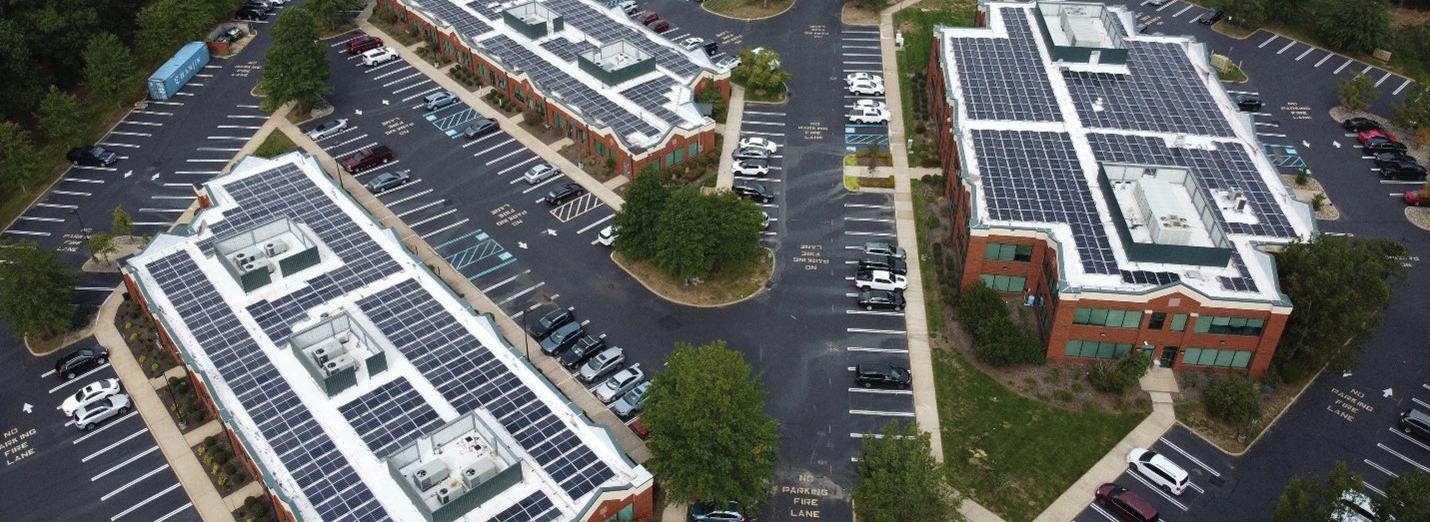
A FEW YEARS on, there is still uncertainty surrounding the solar supply chain. There are likely still modules tied up at shipping ports, and despite Inflation Reduction Act incentives to develop a larger domestic market for solar panels, it will still be some time before we experience it. That is not necessarily the case for solar racking and mounts. Unirac, a manufacturer with more than 20 years in the solar structures space, is geared and ready to tackle commercial solar projects in 2023. We’re joined by Unirac’s commercial business development director, Ted Bleecker, and director of customer solutions, Brandon Carrasco, to discuss what’s ahead for the company in the coming year.
Below is a portion of Unirac’s Solar Spotlight podcast with Solar Power World, but be sure to listen to the full episode on your favorite podcast app.
With the passage of the Inflation Reduction Act, what changes does Unirac see in the market with materials and how are you supporting the industry?

BC: I think, as we as we've seen this IRA legislation, we're excited about it. First of all, there is a lot of tailwinds for the industry. That means nothing but good things for us across the board, as well as our partners, our customers and just the environment in general. But what we're doing is we have a diverse supply chain. So as our customers continue to look for the options to how can they be compliant, the big question for us as a manufacturer is, can we meet the U.S. material requirements? So that doesn't necessarily apply to everybody in every project. However, with our diverse supply chain, we do have a broad base of U.S. supply and material and manufacturing. And that allows us to meet in basically every segment — residential, flat roof and ground — that we work in. It allows us to provide materials and
to provide projects or products for projects that meet those requirements of being U.S. manufactured.


What structural changes do you see in the C&I market?
TB: I think the developers are more active in the engineering, procurement and construction of their portfolios. So, we're seeing a much more active role in the market with development partners. EPCs are getting smarter. I think back 10 years ago, it was a little “cowboy” how projects were installed on rooftops. Today, we're very granular in our approach, with point loads, with dead loads, with applied loads. There's a whole number of factors that a ect the building envelope, and particularly the roof structure. So, it's exciting to be part of a great company like Unirac that has an engineering team that has a back o ce in India that supports us. We're a 24/7 operation now.
How have large format modules a ected racking engineering and designs?
BC: I think the first thing is as modules have continued to increase in size, it requires racking manufacturers to adapt. We and others in the industry have had to make modifications to some of the long goods in, let's say, a ballasted system, where wind deflectors and ballast trays just have to grow to meet the new size ranges of some of the modules that are out there. It also has implications on wind tunnel testing, where the model that may have been tested six, seven, eight years ago is no longer valid for the size of models. They've just outgrown the range of that valid model. So, for Unirac what that's meant is some new SKUs, some new components to ensure that we can handle those larger-format modules, additional testing, as well as a refresh of some of the wind tunnel testing that we've done.
How does Unirac di erentiate itself from other racking companies?
TB: Unirac’s investment in human capital is unequaled in the industry. We're constantly looking to create the best employee base to provide the best customer experience. That's our goal. We are not thin on human representation and support for our customer base, from engineering, to product support, to install support, we’re there throughout. And then secondly, our product development. If you look at all our competitors, nobody is innovating at the pace that Unirac is and that goes from our residential attachments, like our butyl attachments for shingle roofs to metal roofs to multiple flat roof solutions. We're looking at bifacial gains currently with our RM10 system and RM10 Evo and we're innovating with UL 3741 testing across every rack that we have on the market.
What piece of advice would you o er to companies looking to break into the C&I, EPC or developer market?
TB: Right, it's easy, partner with Unirac. We've got the best team on the market to support you, and I say that slightly in jest, but with all seriousness, we have the ability to support you from early stage production reports up to very intense, permit design-ready documentation. We have the full spectrum of product o erings to provide support for your install. Wherever it is, we've got the onsite support for you to install in any market across the country.
BC: That partnership is so important, especially if somebody's stepping into the C&I space. SPW

of Patagonia’s campus, and the power is being used to charge phones and other devices in the employee community spaces.
South
Patented mats that account for thermal expansion




Sliding, self-aligning clamp

Adjustable inter-row spacing
Array density can be optimized per job

Stackable for shipping
Landscape or portrait orientation

“The great thing about PV on commercial buildings is you’re providing power when it’s needed, where it’s needed. You’re lowering the load on the grid rather than increasing it,” said Corey Hoven, chief technology officer for NEXT.


This Patagonia installation is the first major demonstration project for NEXT, which spun out of organic semiconductor research from the University of California, Santa Barbara. Hoven said the company sees most of its potential in the commercial building market. Working with window fabricators and installers like Walters & Wolf will be the key to bringing transparent PV technology into more projects.
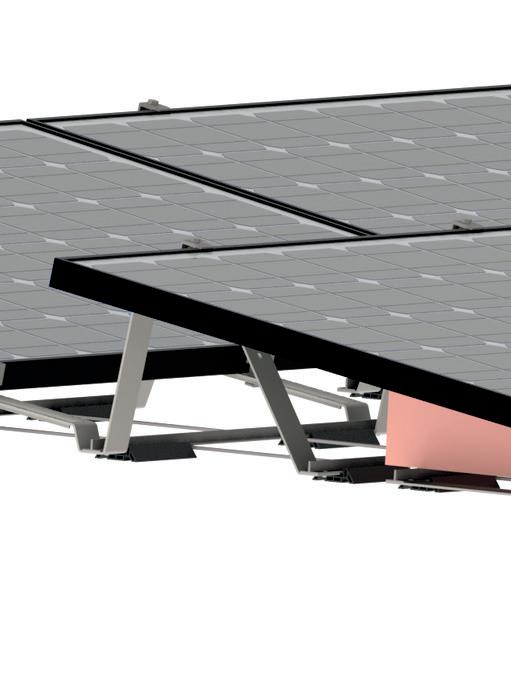
“We’re trying to disrupt a market without disrupting the supply chain,” he said. “There are flat glass manufacturers that make glass and sell it to window fabricators. Window fabricators, where we partner, cut pieces of glass and sell that to window glaziers who then put the frame on it and install it. Our business model is to allow existing manufacturers of windows to manufacture this themselves. Then people can buy the windows from trusted window manufacturers, and you don’t have to reinvent a supply chain from scratch.”




NEXT’s technology consists of a printed transparent photovoltaic coating on glass, which is sealed by a second piece of glass and integrated into a traditional window glazing system. By using organic semiconductors, NEXT is able to absorb more infrared energy than traditional solar, which means less semiconductor is needed to produce energy, allowing the coating to be transparent.
“You don’t realize the cells are there, it’s pretty much invisible,” Hoven said. “At the very edges of the glass are some busbars. Windows in commercial buildings have a frame system already that’s particularly good for carrying wires. You can use rapid shutoffs with power optimizers at the windows. You can connect

them with string inverters, microinverters. It’s like a normal solar installation, but a lot of the [difference] is in the framing that carries those wires.”

Newer commercial windows have electrochromic properties, so window installers are already used to connecting wires. Commercial building architects and window glaziers are the ideal customers for NEXT’s solar window product, but Hoven said there may be future opportunities for traditional solar installers.

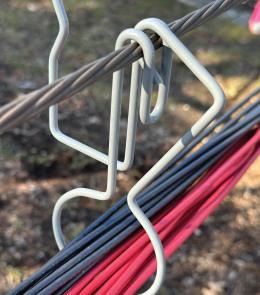

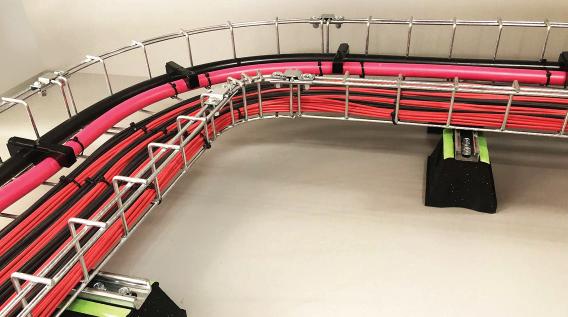

“There’s a ton of opportunity in this market. Right now we’re doing it the most normal way for windows, but there are more opportunities, like the whole façade of the building,” he said.
NEXT Energy Technologies will continue to look for window company partners and work on additional pilot installations in 2023. The transparent solar technology is not in full-scale production yet, but Hoven said the political climate around energy efficiency right now is encouraging.
“The IRA has a huge impact for this,” he said. “Now, your façade of your building can be counted as a solar cell. That’s enormous. People have moved beyond just thinking about fields of solar panels or solar panels on a rooftop. Let’s go to the next stage and make beautiful solar.”
Ubiquitous Energy — starting significant manufacturing by 2025
Another university spinout, Ubiquitous Energy got its start at the Massachusetts Institute of Technology 11 years ago when researchers were exploring ways to make solar more lightweight and flexible. By discovering spectrum engineering and organic photovoltaics, Ubiquitous developed a thin coating that is fully transparent with no color tinting. While acknowledging the potential for solar windows in the commercial building market, Ubiquitous recently signed a manufacturing agreement with leading residential window maker Andersen for its patented UE Power technology.
“When you look at just the windows market, it’s roughly one-half residential, one-half commercial. We really wanted this technology to be ubiquitous, to be everywhere,” said Veeral Hardev, VP of strategy for Ubiquitous Energy.

Ubiquitous is currently making solar windows at its R&D pilot line in California, where it also has functioning solar windows installed on an exterior façade that provide power for overhead LED lighting. UE Power solar windows have also been installed at Michigan State University, a commercial building in Boulder, Colorado, the NSG Pilkington glass development facility in Ohio and throughout Asia. Already a proven technology, Hardev said the relationship with Andersen will allow Ubiquitous to
reach residential customers through a recognized window brand.
“We believe this puts a strong stamp of credibility and validity to what we’re doing, working with someone with that brand reputation and place in the market,” he said. “The next phase would be licensing the technology to manufacturers all around the world. We believe that’s going to be the fastest way to get this technology globally deployed.”
Hardev said there have been many semi-transparent PV products released
Our goal has been to not disrupt the whole flow, to not create unnecessary challenges. We want it to be something that people can easily use and get installed and integrated.Ubiquitous Energy
over the years, but Ubiquitous Energy’s product is “vision glazing” that people actually want to look through.









“I want to look out and see no color or obstructions. We want the consumer to operate it just like a traditional window. You don’t even know that our technology is integrated in there, but it’s giving you all this benefit,” he said.
Residentially, power could be used locally for active window features or connected back into a smart home’s energy settings. Commercial buildings have more window area, making it more logical to feed that energy back into the grid for net metering. Obviously, UE Power windows won’t produce as much as traditional solar, but with more localities mandating renewable energy installed on new commercial buildings, solar windows could provide a significant alternative to small rooftop-solar footprints.
“We’ve certified up to 10% power conversion efficiency. That’s apples-to-apples comparison of efficiency as traditional solar,” Hardev said. “The nice thing about our technology, very similar to how thin-film solar technologies behave, they perform very well in off-angle or diffused light. You don’t really need access to direct sunlight to operate.”

Ubiquitous Energy is continuing to raise money to start a dedicated manufacturing line. Hardev said the company hopes to break ground on the line by the end of this year, with product available for both the residential and commercial spaces in the latter half of 2025.



“We didn’t really invent or develop any new method or process that requires new equipment to be developed. It’s using what the window coating industry already does as part of their day-to-day operations,” he said. “Our goal has been to not disrupt the whole flow, to not create unnecessary challenges. We want it to be something that people can easily use and get installed and integrated.”

Bidirectional EV charging could soon upend the solar + storage installation market.
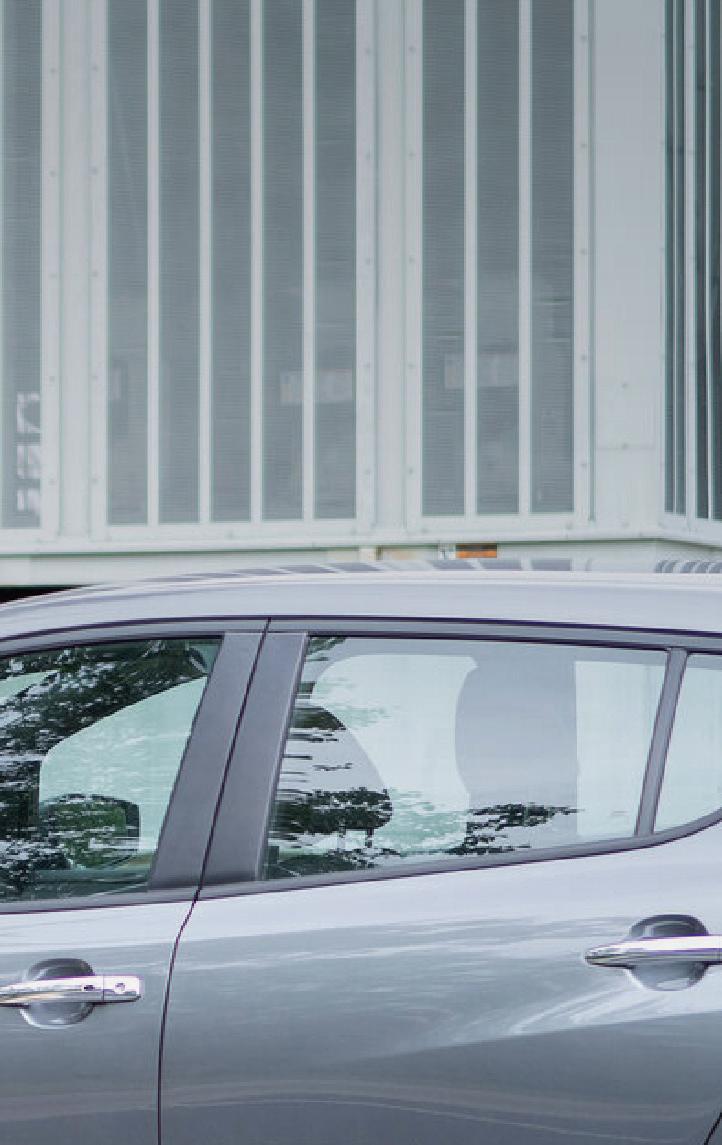



The clean energy market is constantly evolving, and solar installers are used to adapting. Solar hot water installs were quickly overtaken by the shift to rooftop PV. Threats to net metering and more utility shutdowns have required contractors to get comfortable with installing batteries alongside more advanced solar layouts. Just as the industry receives a standalone storage investment tax credit that could accelerate home battery adoption even further, a new product could flip the market on its head again — the bidirectional electric vehicle charger.
An EV’s battery is an underused asset. As a portable energy storage system (ESS) with a much bigger capacity than the stationary ESS sold today, it makes sense to tap into the unit when it’s
just sitting in the garage. The hardware that would allow that to happen, the bidirectional EV charger, should begin hitting the market in earnest later this year or early 2024, and solar installers would be smart to get involved with EVs now, as residential customers begin to understand the preferable economics, said Shawn McLaughlin, CEO of home energy management company Emporia Energy.
“It's much more cost-effective to use your car [as a home battery]. The battery cost is underwritten in the purchase of the car,” he said. “When you look at a home battery system, it costs over $1,000/kWh to install. Leveraging your car battery with a bidirectional charger will cost closer to $50/kWh installed. That’s a big deal.”
A bidirectional charger both charges an EV’s battery and exports its power into a home or onto the grid. This vehicleto-grid (V2G) and vehicle-to-home (V2H) power transfer is also collectively known as vehicle-to-everything (V2X). EV chargers installed today are unidirectional and only transfer power to the battery. Three things are preventing V2X from being a more valuable option: 1) EV brands have to allow the dual power flow, 2) more bidirectional chargers have to be certified and manufactured, and 3) utilities and grid operators have to understand (and compensate) this new distributed energy resource.
Interest is piquing though. When Ford announced its electric F-150 Lightning’s 131-kWh battery could
be used as home backup through its “Charge Station Pro and Home Integration System,” the general public took notice. GM soon announced it was testing V2X capabilities, and power electronics companies like Emporia, Wallbox and Enphase are working on their own bidirectional EV chargers.
V2X software developer Fermata Energy was the first bidirectional charger company to have UL 9741 certification, the standard that covers bidirectional charging equipment and includes functionality to export power to the grid. Fermata’s FE-15 charger was recently joined by Ford’s charger (made by Siemens) as the only two on the market to have UL 9741 certification. Fermata’s FE-15 charger is also the only one approved to work with the Nissan LEAF, the first mass-produced EV in the United States.
Fermata Energy CEO David Slutzky said the market opportunity for V2X is huge — not only for EV drivers wanting emergency backup or compensation for grid participation, but also for utilities and grid operators seeking to gain access to a large network of dispatchable energy assets.
“V2X is enabling the extraction of multiple value streams from parked electric vehicles and presenting them to different customers to enable those vehicles to suddenly become more cost-effective as assets to enable an accelerated deployment of renewable energy on the grid,” he said.
While the benefits to EV owners are more obvious, grid operators tapped in to V2X would get a big energy resource without having to build or maintain a site. As an example, almost 200,000 Nissan LEAFs have been sold in the United States since 2011. With a 40-kWh battery coming standard in the 2023 LEAF, one could estimate almost 8 GWh of battery capacity sitting in garages from LEAFs
alone. In comparison, the United States has spent billions of dollars over the same time period to reach 13.4 GWh of stationary energy storage capacity. Add Teslas, Chevy Bolts, Ford F-150 Lightnings and more to the equation and you can finally understand the grid benefits of V2X, Slutzky said.
“V2X will not displace stationary storage, but it will surround stationary storage and provide enormous additional storage,” he said. “A Nissan LEAF has 4.5 Powerwalls under the hood, and they came free with the leather seats and air conditioning. The Ford F-150 Lightning has more value under the hood in storage than the cost of the vehicle, literally.”
While interest is high, the industry still has to tackle the three setbacks mentioned above to get V2X moving. First, EVs have to allow their batteries to be used in a dualflow situation. Until recently, EV companies were not comfortable with batteries cycling through usage outside of normal driving. Now EV warranties are better reflecting battery usage in V2X situations, and Slutzky said EV models hitting the market today have bidirectional tap-ins.
Bidirectional chargers have been slow to develop because the technology is more advanced than what’s in a
unidirectional EV charger. A more powerful inverter has to be installed to allow for the AC-to-DC power exchange and back again. That dual power transfer generates heat, so more fans and higherrated enclosures have to be used. Automatic transfer switches must be included if the vehicle wants to work with the grid. Add in software developments to ensure the consumer can use the charger like any other smart device and the utility can access that power, and suddenly you have a much bigger and more complicated product to manufacture.
That’s what Emporia Energy is learning. The home energy management company makes
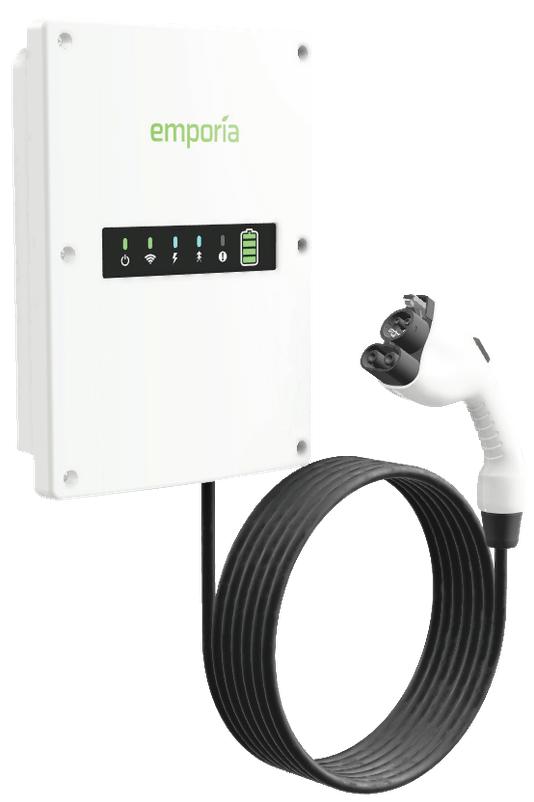
smart plugs, energy monitors, ESS and traditional EV chargers and announced in early 2022 it would make an affordable bidirectional charger. McLaughlin said the company is working through certification and testing and is hopeful that the Emporia V2X Charger will hit the market in 2024.

“It’s a lot more than a Level 2 charger, when you think about the power conversion and the heat it generates. Then the need for an automatic transfer switch, and you’ll need an energy monitoring system to detect when the grid is down. Then you throw in IEEE (Institute of Electrical and Electronics Engineers) voltage control standards,” he said. “All of these things just stacked. It all adds up.”
Perhaps most important is getting utilities tuned in to the benefits. That’s where companies with grid functionality software will have a leg-up. Emporia is well-versed in helping customers participate in grid programs, and Fermata would actually prefer to be the V2X software provider other bidirectional chargers use. Fermata has already worked with different utilities to devise new monetization mechanisms to access V2X’s value streams.
The company’s V2X software is allowing an EV used by Burrillville, Rhode Island, city employees to send power back to Rhode Island Energy (formerly National Grid) and get compensation through the ConnectedSolutions program. Another Fermata setup in Boulder, Colorado, reduced peak power demand on a city building and saved the city an average of $270/month — approximately the monthly payment for the Nissan LEAF.




“Most people today are thinking about V2H as backup power and that’s because of the Ford Lightning. Once people understand that we can produce energy savings on our utility bills through grid parity, that’s going to change pretty quickly,” McLaughlin said. “Early adopters will buy for backup, and then when they can reduce their energy bill by 50%, word of mouth will spread. Within the next three or four years, the majority of use will be managing energy efficiency and savings during grid parity vs. just using during grid outages.”

Where the solar installer fits
An EV charger installation is not plugand-play, and contractors familiar with electrical hookups will be needed to equip more homes and businesses with the bidirectional product. If solar installers know how to install an ESS or a solar inverter, they can install a bidirectional charger.
“Installing a bidirectional charger is similar to installing solar plus a battery inverter. Installing a bidirectional charger may be a little easier because you’re not dealing with big, heavy battery modules,” McLaughlin said. “Of course you’ll have to install it where it can access the EV, but the actual electrical work will be very similar but a little less complex than batteries.”
Some solar contractors are already looking ahead. Kevin Nickels, VP of sales for residential installer Nickels Energy Solutions (NES), said his crews are looking forward to bidirectional EV opportunities hitting the market. With more customers wanting energy storage

but not comfortable yet with its pricing, Nickels said bidirectional charging could change their sales conversations.
“On almost every customer interaction, the topic of energy storage is coming up. People want it, but then there is some sticker shock that quickly follows the quoting conversation,” he said. “The thing that excites me about the bidirectional EV charger is you’re going to be tapping into a way larger battery. The fact that EV chargers will be less expensive [than a stationary ESS] and you’ll be able to tap into way bigger batteries, it feels like the better solution for homeowners.”
Nickels also believes bidirectional charger installation will keep NES busy during the off-season solar months in upstate New York.
“I don’t want to have a massive team because in the winter we really do slow down,” he said. “But if EV chargers become a really common thing for us, that would be a perfect winter work scope.”
McLaughlin believes the bidirectional EV charger installation market will increase solar opportunities for contractors.
“I think the majority of bidirectional installs will be done by folks that don’t have solar systems. The EV market is enormously bigger and is growing much faster than the solar installation business. You’ll have a lot of opportunity as a solar installer,” he said. “Your introduction to the customer will be with a bidirectional sale and install. A lot of those customers will be natural customers to install solar either at the time of the bidirectional or you will be able to upsell them to solar in the future.
“As a solar installer, it’s going to be a great opportunity to add additional revenue streams and build out an additional customer base for future solar installs,” McLaughlin continued. “Constant customer acquisition is so expensive, so to be able to resell to existing customers is going to be so much more profitable.” SPW





































THENorth American Board of Certified Energy Practitioners is organizing its 12th annual NABCEP Continuing Education Conference to be held from March 27 to 30 at the St. Charles Convention Center in St. Charles, Missouri.
NABCEP CE is a conference built around the organization’s certification program, giving attendees the opportunity to earn credits toward solar installation certificates. NABCEP is a prominent certifying body in U.S. solar, and attendees can leave the event with approximately 80% of the credits required to be NABCEP-certified.
“The design of the conference was multi-purpose in the sense that it’s a good way to get people who are interested in solar together. It’s one of those ‘catch up with your friends’ type of social events,” said Eric Filante, project coordinator at NABCEP. “At the
same time, we do want to implement a schedule of rigorous training.”
Founded in 2011, the conference features training sessions from industry experts, social events, product demonstrations, a show floor of exhibiting manufacturers and an opportunity for solar installers to connect in person. Unlike a manufacturer-centered trade show, NABCEP CE focuses on the practice of solar installation, with sessions on solar + storage, sales, system design, operations and maintenance and system inspection. There are breakout sessions, keynote speakers, awards, scholarships and social events.
Following pandemic restrictions, NABCEP’s in-person industry conference is back in full swing, and the organization is pursuing projects it put on hold through that time. Solar installers can expect updates
to existing certifications at the show and new installation certifications later this year. The organization is also anticipating record numbers for attendance this year in St. Charles.
"The relationships we built with certain companies and with certain training providers and other businesses like ours, seeing that all come together is really the draw," Filante said. "It's a rewarding experience to them, because they're not only seeing the company grow, but they're seeing the validity of their certifications grow."
Like Solar Power World’s mission, NABCEP is installer-focused, so in the following pages we’ve fielded some advice from the people putting in work on rooftops and beyond. Read on for their input on preferred equipment, lessons learned on the job and questions about new technology coming to market.
What’s your favorite installation tool?
My favorite tool is my auto-adjusting KNIPEX pliers. There hasn’t been a single day I’ve gone without using them in the field. When I first was shown them in person, I asked what they were called, and the response I gave was, “Mine!”
What’s a piece of clothing you can’t live without on the job?
I never leave the house without a pair of sunglasses!
What’s the best solar install tip you won’t find in a manual?

The best tip you can’t find in a manual is to stay limber! At Alaska Solar, we start our day off with 15 minutes of stretching every morning. Without that,
we would be installing half the projects we normally do.
What's a question you have about a new solar product or installation process?
I’m curious about S-5!’s SolarFoot deck mount. Nothing saves time like using a deck mount on an asphalt roof, and we are on the search for a deck mount for metal roofs.
What's an install tip you learned the hard way?
Always measure twice when placing your junction box on the rail! Nothing hurts as much as moving a junction box at the end of the day when the crew is placing the last panel on the roof.
Rain gear is a must! I have a light rain shell from REI for wind and light rain and a Grundens rain jacket for when it gets really froggy.
–– Jack Carpenter • Crew Lead Alaska Solar • Anchorage, Alaska



I can’t live without a long-sleeved shirt because it’s too hot on the roof to wear anything short-sleeved without burning my arms on metal. Plus, I won’t get a tan or sunburn.
–– Deshawn Ellison • Crew Lead Energy Service Partners Chino, California
Blåkläder pants with tool pouch and knee pads built-in and a wide-brimmed hat.
–– Doug • Field Engineer Freedom Solar Power • Austin, Texas
Probably a hat, whether it’s a bright sunny day or cloudy day. I use my hat to carry SunRunner clips — I stick them on the brim, and it’s an easy way to keep them without spilling them all over a roof.
–– Tristin Hobbs • Electrician ION Solar • Provo, Utah
Cougar Paw boots.
–– Andrew Ramos • CEO Suncatch Solar • Orlando, Florida
Invest in a good sunhat.
–– Rudolfo Gil • Electrical Lead Titan Solar Power • Mesa, Arizona
What’s your favorite installation tool?
Impact driver. This tool is used throughout the entire installation process by both solar installers and electricians and is a vital tool. Anchors, railing, conduit, inverters, meters, solar panels and more all need an impact driver.

What’s a piece of clothing you can’t live without on the job?

Work pants. My work pants have plenty of pockets for hand tools or installation hardware, there are loops to clip other tools, and they have built-in knee pads, which help protect my knees from the roof surface. It is essential to have the ability to carry tools and other equipment while your hands are free, so the loops and pockets are always essential. The knee pads help to protect my knees from hot and abrasive surfaces on the roof. Knee pads that slide over pants tend to move around throughout the day and constantly need to be adjusted to cover the knees.
What’s the best solar install tip you won’t find in a manual? Make absolutely certain that the first solar module anchored to the roof is level and square from the ground. Also, have someone on the ground check and adjust the level often while team members on the roof install more panels. The first panel is used as a cornerstone for the rest of the array, and monitoring/adjusting the level constantly will avoid the scenario where the array looks unprofessional at the end of the installation, resulting in resetting the panels after the work should be finished.
What's an install tip you learned the hard way?
Black ice can be as hard to see on roofs as it is anywhere. Be sure of your footing before committing too much of your weight to an area that you haven’t walked on yet.
Fast isn’t always fast. Keeping a steady pace while checking yourself and your crew is the fastest way to install. If everybody gets into a rush, you’re bound to forget something. Then you’ll have to take panels up or do things over.
–– Jack Carpenter • Crew Lead Alaska Solar • Anchorage, Alaska

Do your homework before you get on the jobsite and pay attention to details so you don’t install an array on the wrong side of the house. Oops!

–– Deshawn Ellison • Crew Lead Energy Service Partners • Chino, California

Verify material and plan the job prior to arriving onsite.
–– Doug • Field Engineer Freedom Solar Power • Austin, Texas
Never cut a corner early on in the install or try to do it the “easy way.” It is easier to get the right result when you make every effort along the way to get it right the first time. Rework is much more difficult than taking the time and effort to get it exactly right from the beginning.
–– David Harper • Installer Solar Energy World • Elkridge, Maryland
Knowing how to do the installation is just half of the job. You also have to know how to lead and manage a team while doing the install.
–– Rudolfo Gil
Electrical LeadTitan Solar Power Mesa, Arizona
My favorite everyday, basic installation tool is Milwaukee’s M12 Impact Driver. We use it all day, every day! It is lightweight, durable and versatile. It has the power to get the job done! Another tool that I like is the Milwaukee M12 Cable Cutter. Though it’s not as much of a necessity as the impact driver, it makes wire cutting so much easier and faster when you are dealing with bigger sizes.
The best piece of clothing that I just can’t live without are my Carhartt overalls. Working in Wisconsin winters, they are essential for maintaining your ability to withstand frigid temperatures. As they say, there’s no bad weather, just bad gear... Carhartt’s overalls stand up to working outside all day in all conditions.
A solar install tip that you can’t find in a manual is how to use a string line appropriately to achieve straight lines on commercial installs. It’s kind of an art and a science combined to eye a line and maintain a clean edge on your panels. The end result of looking down a long row of neat panels is pretty satisfying!
WHAT’S A QUESTION YOU HAVE ABOUT A NEW SOLAR PRODUCT OR INSTALLATION PROCESS?

My question about a new solar product or installation process has to do with energy storage systems (ESS), and it’s a bit of a hypothetical question: How will ESS affect codes and regulations? Battery backup systems are becoming ever more common and the technology is rapidly evolving, so I am wondering and curiously watching to see how the codes and regulations for installs change. It’s interesting to see the interplay between invention and regulation.
An install tip I learned the hard way is to watch the weather. Consistently! Just checking once at night before you go to bed and once in the morning is never enough. It is a wise practice to get in the habit of checking at certain intervals throughout the day, and if you know bad weather is on the horizon, make sure you have one person on your team who is designated to check more frequently as a weather system approaches. In solar, “The Weather” is sort of an invisible member of your team that can easily sway how an install goes, for better or worse! Early in my install career, we didn’t
look closely enough at a storm that was coming in. All of a sudden, we were just a few minutes away from having to stand down for lightning. We ended up having to race to secure panels down before exiting the site. It’s not fun to be caught in a rush between potential panel damage and personal safety. Always be prepared!
How common will bidirectional charging be in the future?
Vehicle to home (V2H) or vehicle to grid (V2G).
 –– Doug • Field Engineer
–– Doug • Field Engineer
Freedom Solar Power • Austin, Texas

I would like to be part of a building-integrated PV installation just to see how it goes together. I’m glad to see the industry moving forward all the time.

 –– Tristin Hobbs • Electrician
–– Tristin Hobbs • Electrician
ION
Solar • Provo, Utah

What’s your favorite installation tool and why?
The impact driver — it does everything! From putting in feet to clamping down modules, most of the work I do involves the use of the impact.
What’s a piece of clothing you can’t live without on the job and why?
UV-protected hat and shirts. We are exposed to the sun’s rays almost every day for long periods of time, and we must protect our skin!
What’s the best solar install tip you won’t find in a manual?
Build trust with your team/crew. This is a very dangerous job and you really do have to trust people with your life when you are up on the roof using ladders and tools, and larger machinery.
What's a question you have about a new solar product or installation process?
I am interested in learning more about trackers. I've only ever been a part of one tracker installation, but I love how they look and think I would like to have one someday.
What's an install tip you learned the hard way?
The way someone else accomplishes a task may not be the way you should do it. The first time I tried carrying modules on the roof, I threw it up onto my shoulder and fell backwards onto the rail. This is the way I had seen my crewmates do it, but they were all 6 ft or taller guys, and I'm quite a bit smaller than them. It was discouraging at first until I figured out a way that works for me. If it's safe and it gets the job done, it shouldn't matter that it doesn't look exactly the same as the way someone else would do it.
My favorite installation tool is, without a doubt, my DEWALT impact driver.
Honorable mentions: Shoutout to my Klein Tools wire strippers and my chalk line. I prefer red chalk, but I’ll accept orange and green, too.
–– Jack Carpenter • Crew Lead Alaska Solar • Anchorage, Alaska


A FLIR camera for infrared thermography, a Fluke 393 Clamp Meter and a Milwaukee M12 Torque Wrench.
–– Doug • Field Engineer Freedom Solar Power • Austin, Texas
Milwaukee 3/8 impact driver. With the one key feature, you can set custom torque settings that are great for cinching all your clips.
–– Tristin Hobbs • Electrician

ION Solar • Provo, Utah
My favorite installation tool is my Milwaukee impact driver just because it’s the most satisfying thing in the world to drive a 3-in. lag bolt into a solid piece of structure and feel it tighten down.
–– David Harper • Installer Solar Energy World Elkridge, Maryland
The bender. Bending conduit is how an electrician shows how good they are at their trade.
–– Rudolfo Gil • Electrical Lead Titan Solar Power • Mesa, Arizona
Solar Energy World
What’s your favorite installation tool? There are two things I’ve become a big fan of — and both relate to ease of movement and safety. I was doing installs for years before I realized the benefit of a good pair of shoes. Vans skate shoes or Cougar Paws make life on the roof much more safe and easy. There is also a new product out there called Pitch Hoppers. They create a stable surface on the roof, and they’ve replaced all of the old couch cushions we’ve sacrificed. They’re worth their weight in gold — or couches, at least.
What’s a piece of clothing you can’t live without on the job?
Unless you’re really into heat stroke or own stock in suntan lotion, a widebrimmed straw hat and a light, longsleeved button-up shirt is essential for working in the hot and humid Indiana summers.

What’s the best solar install tip you won’t find in a manual?
Get the bottom rail installed first. It becomes a toe-hold for building out the rest of the array. You’re basically building a ladder on the roof from there up. Also, something we’ve been encouraging the crew to do is make sure that they install the DC conduit and junction box ASAP. This allows the ground crew and roof crew to decouple and move on to another job.
What’s a question you have about a new solar product or installation process?

I’ve always hesitated to be a guinea pig for brand-new products, so I tend to stick
with what’s tried and true. However, I see a lot of possibilities for rail-less mounting systems and pucks (flash-less) for roofing attachments, but I’ve yet to make the leap. That being said, I was an early adopter of the SnapNrack system and I have no regrets there!
What’s an install tip you learned the hard way?
I learned that the most efficient way to get panels from ground to roof is to simply shoulder them up a ladder. Originally, it was a two-person process, but a few years back, one of our new crew members shouldered a panel and walked it up the ladder, and we haven’t looked back. The other key point in regard to workflow — I’m a big believer in getting the worst part of a job done first. So we like to stage panels on the roof (on Pitch Hoppers) first, take a little break, then install them.
Pretend that every install is for your parents or someone you really respect and care for. Go the extra mile. If your clients are in their 70s, clean out their gutters while you’re up there. Clean up after yourself. Take pride in your work. Take care of each roof and each array like it’s your own. It will show.
––Jack Carpenter • Crew Lead Alaska Solar • Anchorage, Alaska
Load some Sprite into a Super Soaker then apply it to metal roofs for extra grip.
––Doug • Field Engineer Freedom Solar Power Austin, Texas
Learn all you can. I haven’t ever done an install completely by myself, but I like to know I could if I needed to.
––Tristin Hobbs • Electrician ION Solar • Provo, Utah
Have some basic integrity in your work. No manual will cover this, but it really goes a long way. Nobody else may ever know, or it could take many years for them to discover your mistake, but you will know.
––David Harper • Installer Solar Energy World Elkridge, Maryland
Check your strings from the junction box before you slap down panels.
––Andrew Ramos • CEO Suncatch Solar • Orlando, Florida
CONTRACTOR’S CORNER:
A foundation of solar repair work builds a dedicated customer base for this small residential installer.
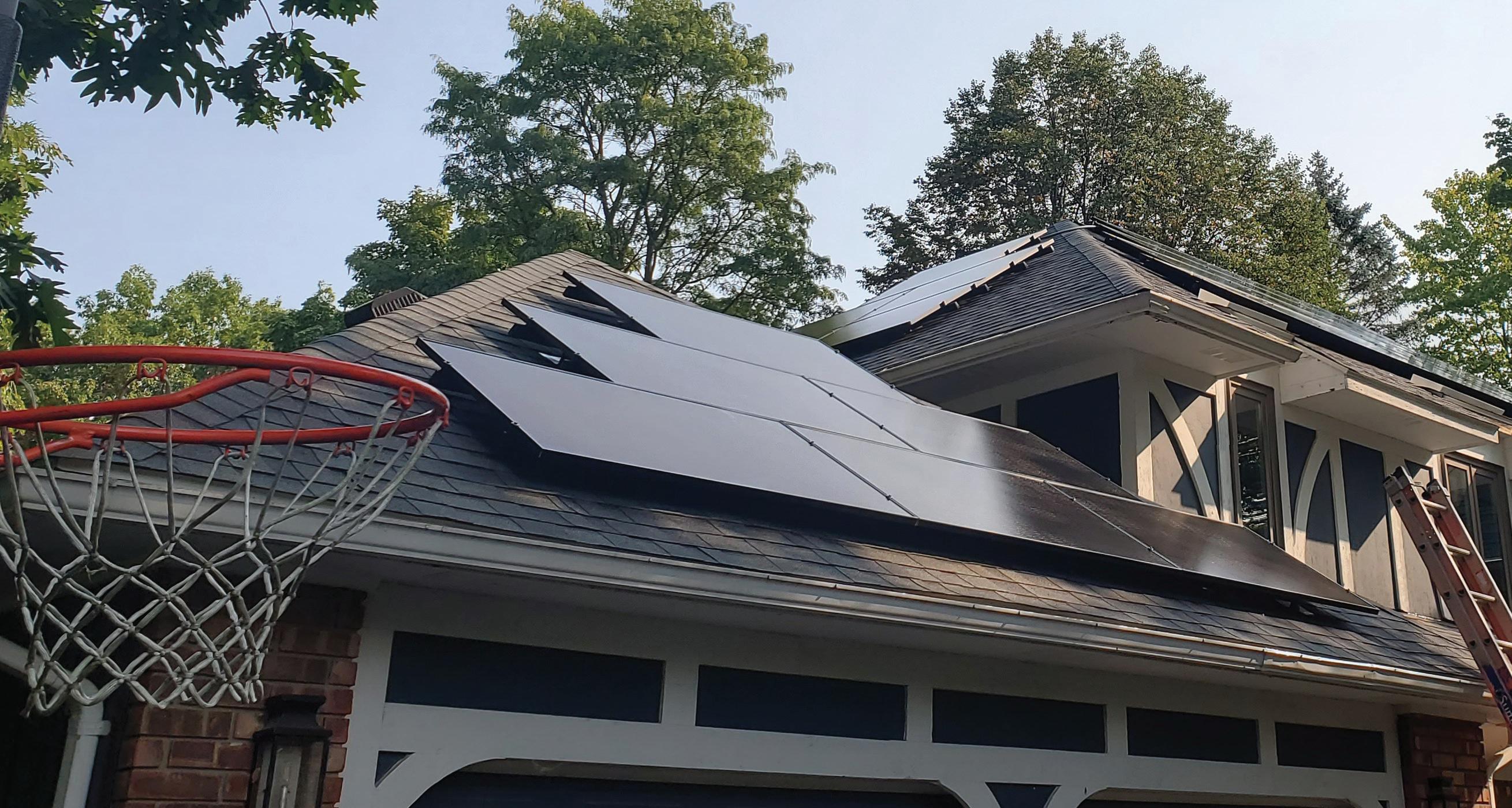
Big, national solar installers often command many headlines thanks to vast marketing and public relations budgets, but when bad things happen and those companies close up shop, small local contractors are the ones that pick up the pieces.
Such was the case for Detroit, Michigan-area installer Sumpter Solar Services when a national solar outfit active in the area closed its doors in 2022. Sumpter Solar got right to work helping customers fix faulty systems or plan new solar arrays they were promised. Owner Matt Kadwell takes pride in his small-but-nimble team’s attention to detail and commitment to new and existing customers.
An edited portion of the interview is below, but be sure to listen to the full podcast for more insight on how the longterm ITC tempered the usual end-of-year installation rush.
Find the Contractor’s Corner podcast on your favorite podcast app.
SPW: Can you start off by telling me a little bit about the size of your business and the scope?
Kadwell: The business is split pretty evenly between new installations and repair jobs. We started the whole business back in 2017 only doing repair work for other companies. So we didn’t do any installs at all for a couple years. Right now, we have eight employees and we do about 100 new installs a year and then some 400 repair jobs.
We get a lot of comments on our site saying people have been left in the dark by an installer, looking for someone to help.
Yes, we’re glad to help. Especially recently, there was a company that went bankrupt out of North Carolina. We’ve done a huge amount of work from that. We’ve been working through this as quick as we can here to help people out.
Has that been mostly bringing inverters back online?
It’s been a variety of different things, anywhere from upgrading communication equipment, and inverters that either have failed or just were never commissioned all the way in the first place.
Would you say that your repair work helps you get more new jobs, too?
Yes, I think so. We have a very, very small marketing budget. We rely almost exclusively on referrals, so the more we can get out in front of the people, the more referrals we’re going to get. Our crews do a good job, so it just builds itself that way.
How else does Sumpter Solar stand out from other local installers in your area?
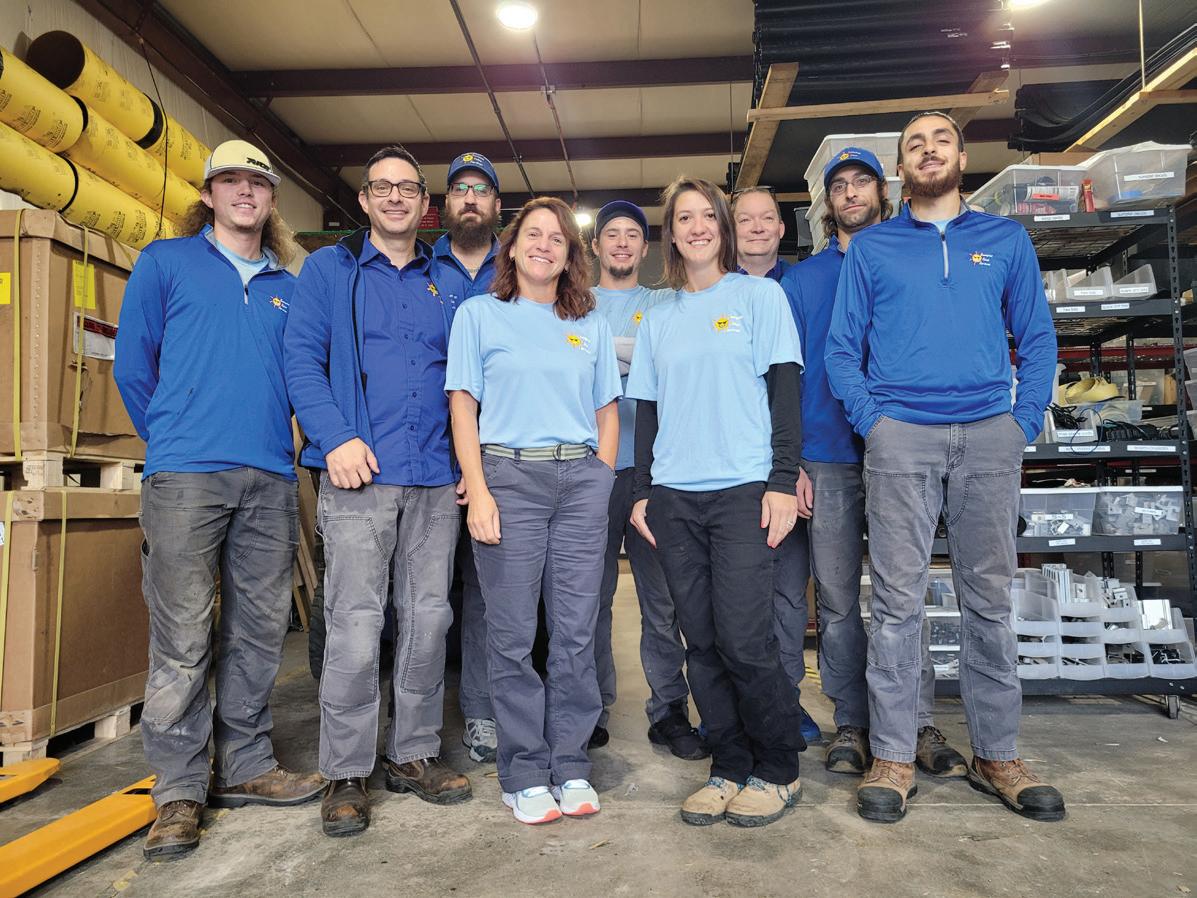


We’re just not a production-based company, where other companies just pound them in as quick as they can and move on to the next job. We end up working with customers for longer if there are ever any service issues or warranty problems or anything like that. We deal with jobs a lot of other companies would walk away from, which sometimes the crew doesn’t always appreciate, but it’s worked out really well. SPW








VP of Sales

Mike Emich 508.446.1823 memich@wtwhmedia.com
Managing Director
Scott McCafferty 310.279.3844 smccafferty@wtwhmedia.com
EVP
Marshall Matheson 805.895.3609 mmatheson@wtwhmedia.com
Associate Publisher

Courtney Nagle cseel@wtwhmedia.com 440.523.1685
Jim Powers 312.925.7793 jpowers@wtwhmedia.com
Ashley N. Burk 737.615.8452 aburk@wtwhmedia.com
Jami Brownlee 224.760.1055 jbrownlee@wtwhmedia.com


Technology evolves quickly. Keep up with CPS America 250/275kW 3-phase string inverters designed to work with solar sites from 2MW to 2GW.
Significant design flexibility for solar plants of all sizes



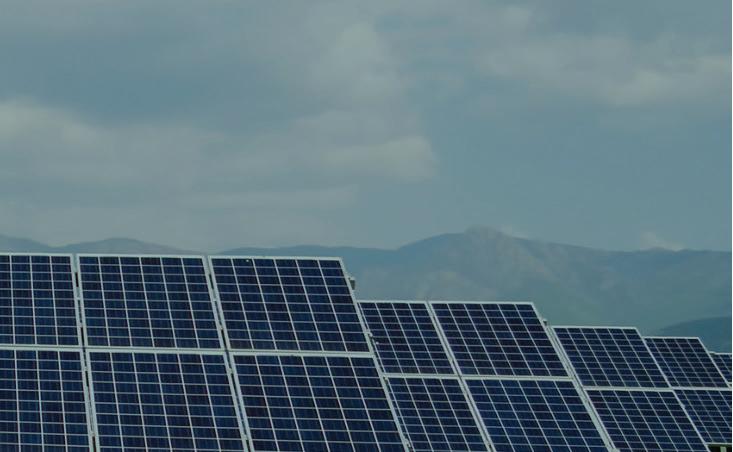


More granular data analytics and monitoring

Available now, without the long lead time
When maintenance is required, only 275kW is impacted versus 5MW, minimizing harvest loss. Get back up and running quickly with service performed by local electricians instead of waiting for highly specialized manufacturer’s technicians.


Welcome to a new era in solar with CPS America string inverters. www.chintpowersystems.com
























